Getac Technology ZX70N RFID and NFC Module User Manual ZX70 English Manual add IC terms
Getac Technology Corporation RFID and NFC Module ZX70 English Manual add IC terms
Contents
- 1. User Manual(host)
- 2. Users Manual (module)
User Manual(host)

Rugged Mobile Computing Solutions
ZX70
USER MANUAL
October 2016
T
TT
Trademarks
rademarksrademarks
rademarks
Google and Google Play logo are trademarks of Google Inc.
The Bluetooth word mark and logos are owned by the Bluetooth SIG, Inc.
All other brand and product names are trademarks or registered trademarks of their
respective companies.
Disclaimer
DisclaimerDisclaimer
Disclaimer
Specifications and manuals are subject to change without notice. Getac assumes
no liability for damage incurred directly or indirectly from errors, omissions, or
discrepancies between the device and the manuals.
Notes
NotesNotes
Notes
Depending on the specific model purchased, the color and look of your device and
accessories may not exactly match the graphics shown in this document.
The screenshots and other presentations shown in this document are for reference
only. They may differ from the actual screens and presentations generated by the
actual product.
Your device is based on Google’s Android 5.1.1 operating system, with additions

by Getac.
For the latest version of the manual, please visit the Getac website at www.getac.com.

i
Table of Contents
Table of ContentsTable of Contents
Table of Contents
Chapter 1
Chapter 1Chapter 1
Chapter 1
Getting Started
Getting StartedGetting Started
Getting Started
................................
................................................................
..................................................
....................................
..................
1
11
1
Identifying Hardware Components ........................................ 1
Front Components ........................................................ 1
Back Components ........................................................ 3
Top Components .......................................................... 4
Bottom Components ...................................................... 5
Left-Side Components ................................................... 6
Getting Your Device Ready for Use .................................... 7
Installing the SIM Card (Select Models Only) .................. 7
Connecting to AC Power and Charging the Battery ............ 8
Performing the Initial Startup .......................................... 9
Chapter 2
Chapter 2Chapter 2
Chapter 2
Basic Skills
Basic SkillsBasic Skills
Basic Skills................................
................................................................
........................................................
................................................
........................
10
1010
10
Waking Up and Shutting Down ......................................... 10
Navigating on the Screen................................................. 10
Touch Mode .............................................................. 12
Auto Rotate ............................................................... 12
Home Screen ................................................................ 12
Extensions to the Home Screen .................................... 13
Customizing Your Home Screen ..................................... 13
Using Applications ........................................................... 14
Navigation Bar ............................................................... 14
Status Bar and Notifications Panel ..................................... 15
Quick Settings ............................................................... 15
Entering Information......................................................... 16

ii
Chapte
ChapteChapte
Chapter 3
r 3r 3
r 3
Getting Connected
Getting ConnectedGetting Connected
Getting Connected................................
................................................................
...........................................
......................
...........
17
1717
17
Wireless Connections ....................................................... 17
Using WWAN (Select Models Only) .............................. 17
Using Wi-Fi Networks ................................................. 17
Using the Bluetooth Function ......................................... 18
External Connections ....................................................... 19
Using a MicroSD Card ................................................ 19
Connecting to a Computer via USB .............................. 20
Chapter 4
Chapter 4Chapter 4
Chapter 4
Android Preinstalled Applications
Android Preinstalled ApplicationsAndroid Preinstalled Applications
Android Preinstalled Applications
.................
..................................
.................
22
2222
22
Google Applications Overview ........................................... 22
Camera ....................................................................... 24
Taking Pictures .......................................................... 24
Taking Panoramic Pictures ........................................... 25
Shooting Videos ......................................................... 25
Chapter 5
Chapter 5Chapter 5
Chapter 5
Getac Applications
Getac ApplicationsGetac Applications
Getac Applications
................................
................................................................
..........................................
....................
..........
27
2727
27
Barcode Utility and Configuration (Select Models Only) ....... 27
Barcode Utility ........................................................... 27
Barcode Config .......................................................... 29
File Manager ................................................................ 30
Button Descriptions ..................................................... 30
Opening a File ........................................................... 31
GPS-ECompass ............................................................ 32
Satellite Position ........................................................ 32
Electronic Compass .................................................... 33
Location Information .................................................... 34
Settings ................................................................... 34
GPS Logging ............................................................ 35
RFID Reader Utility (Select Models Only)......................... 36
GU1000 UHF RFID Reader (Select Models Only) ............. 37
Chapter 6
Chapter 6Chapter 6
Chapter 6
Managing Your Device
Managing Your DeviceManaging Your Device
Managing Your Device................................
................................................................
.....................................
..........
.....
39
3939
39
Managing Power ............................................................ 39
Low Battery Signals and Actions ................................... 39
Power-Saving Tips ..................................................... 40
Settings ........................................................................ 41

iii
Wireless and Networks Settings ..................................... 41
Device Settings ......................................................... 42
Personal Settings ....................................................... 43
System Settings ......................................................... 44
Chapter 7
Chapter 7Chapter 7
Chapter 7
Care and Maintenance
Care and MaintenanceCare and Maintenance
Care and Maintenance
................................
................................................................
....................................
........
....
45
4545
45
Resetting Your Device .................................................... 45
Caring for Your Device .................................................. 45
Chapter 8
Chapter 8Chapter 8
Chapter 8
Regulatory Information
Regulatory InformationRegulatory Information
Regulatory Information
................................
................................................................
..................................
....
..
47
4747
47
Regulations Statements ................................................... 47
USA Class B Regulations ............................................ 47
European Union CE Marking and Compliance Notices ........ 51
Safety Precautions ......................................................... 52
About Charging ......................................................... 52
About the AC Adapter ................................................ 52
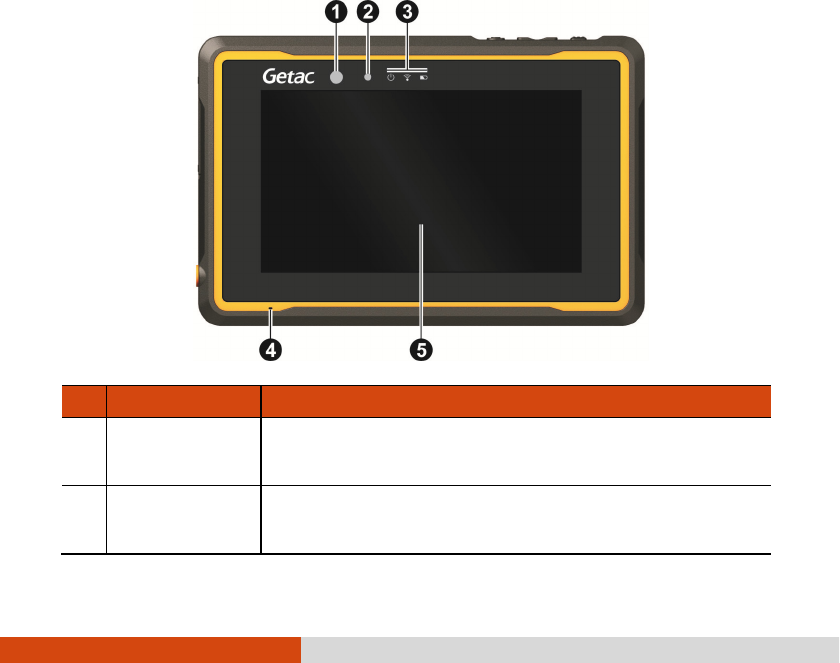
1
Chapter 1
Chapter 1Chapter 1
Chapter 1
Getting Started
Getting StartedGetting Started
Getting Started
This chapter introduces you to the external components of your device and guides
you through the process of setting up your device for use.
Identifying Hardware Components
Identifying Hardware ComponentsIdentifying Hardware Components
Identifying Hardware Components
Front Components
Front ComponentsFront Components
Front Components
Ref
RefRef
Ref
Component
ComponentComponent
Component
Description
DescriptionDescription
Description
Camera
Camera Camera
Camera l
ll
lens
ensens
ens Takes still pictures or records video clips.
The front lens
supports 2 MP.
Light
Light Light
Light s
ss
sensor
ensorensor
ensor
Senses the ambient light
for automatic adjustments of the
display backlight.
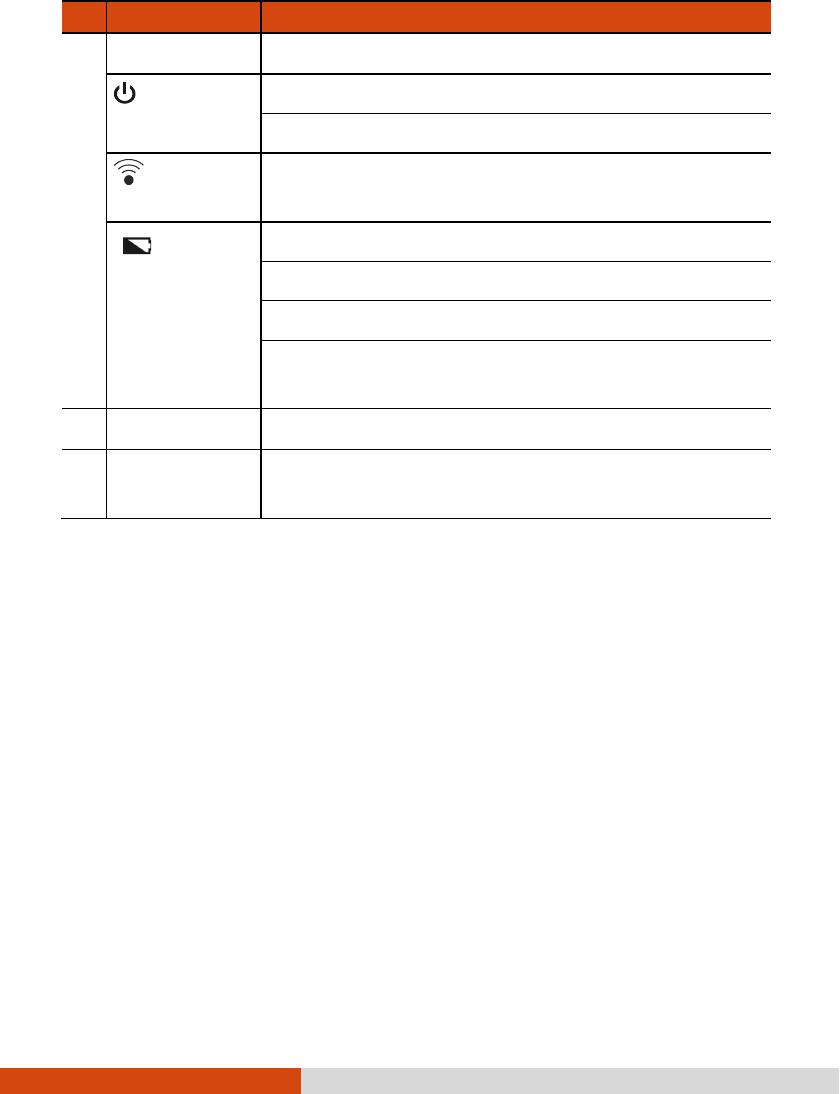
2
Ref
RefRef
Ref
Component
ComponentComponent
Component
Description
DescriptionDescription
Description
Indicators
Power Lights blue when the device is turned on.
Blinks blue when the device is in Sleep mode.
RF (Radio
Frequency)
Blinks blue when the RF radio of any RF feature
(WLAN/Bluetooth/WWAN) is on.
Battery
Battery Battery
Battery
Charge
Lights amber when the battery is being charged.
Lights green when battery charging is completed.
Blinks red when the battery’s capacity is below 10%.
Blinks amber
when the battery charging is in an abnormal
state. Replace the battery in case this happens.
Microphone Receives sound and voice.
Touch screen Displays the output of your
device and responds to your
touching.
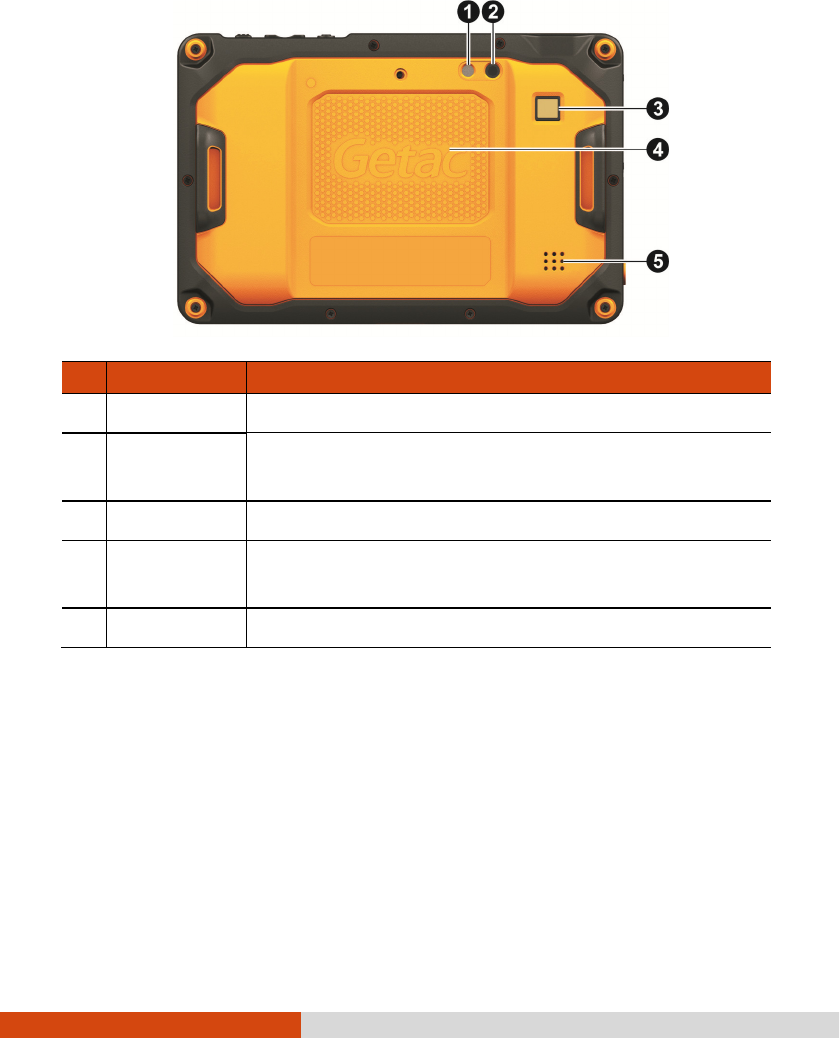
3
Back Components
Back ComponentsBack Components
Back Components
Ref
RefRef
Ref
Component
ComponentComponent
Component
Description
DescriptionDescription
Description
Flash
FlashFlash
Flash
Provides extra light when taking pictures.
Camera
Camera Camera
Camera l
ll
lens
ensens
ens Takes still pictures or records video clips. The rear lens
supports 8 MP with auto focus.
Reserved
ReservedReserved
Reserved
RFID a
RFID aRFID a
RFID antenna
ntenna ntenna
ntenna
(optional)
Inside is the RFID antenna that reads RFID
(Radio-frequency identification) tags.
Speaker
SpeakerSpeaker
Speaker
Plays music, sounds and voices.
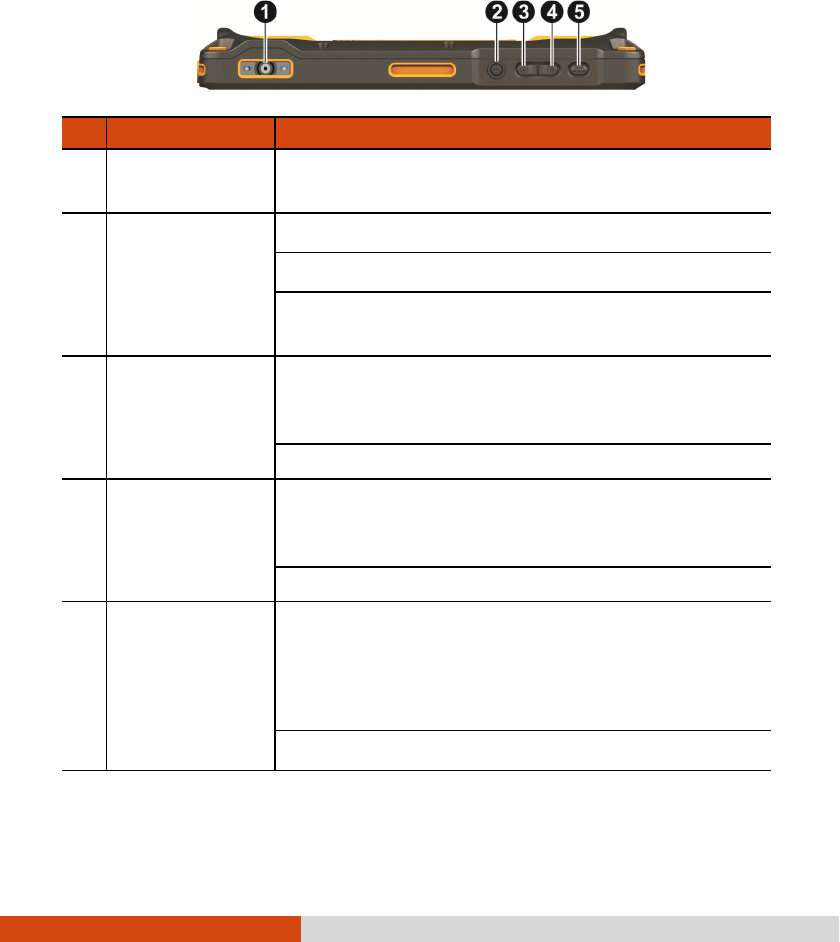
4
Top
TopTop
Top
Components
ComponentsComponents
Components
Ref
RefRef
Ref
Component
ComponentComponent
Component
Description
DescriptionDescription
Description
Barcode reader
lens (optional)
Scans and reads barcodes.
Power button Starts up your device.
Turns off or restores the screen.
When pressed longer:
Opens a menu with Power off option.
Minus button Decreases the sound volume (default setting).
The type of sound adjusted depends on the current
operation.
Can be assigned to a different function through Settings.
Plus button Increases the sound volume (default setting).
The type of sound adjusted depends on the current
operation.
Can be assigned to a different function through Settings.
Fn (Function)
Fn (Function) Fn (Function)
Fn (Function)
button
buttonbutton
button
Provides the “trigger” function (default setting).
Depending on your model, it serves as one of the below.
- Trigger button for the barcode reader/RFID reader.
- Shutter button for the camera.
Can be assigned to a different function through Settings.
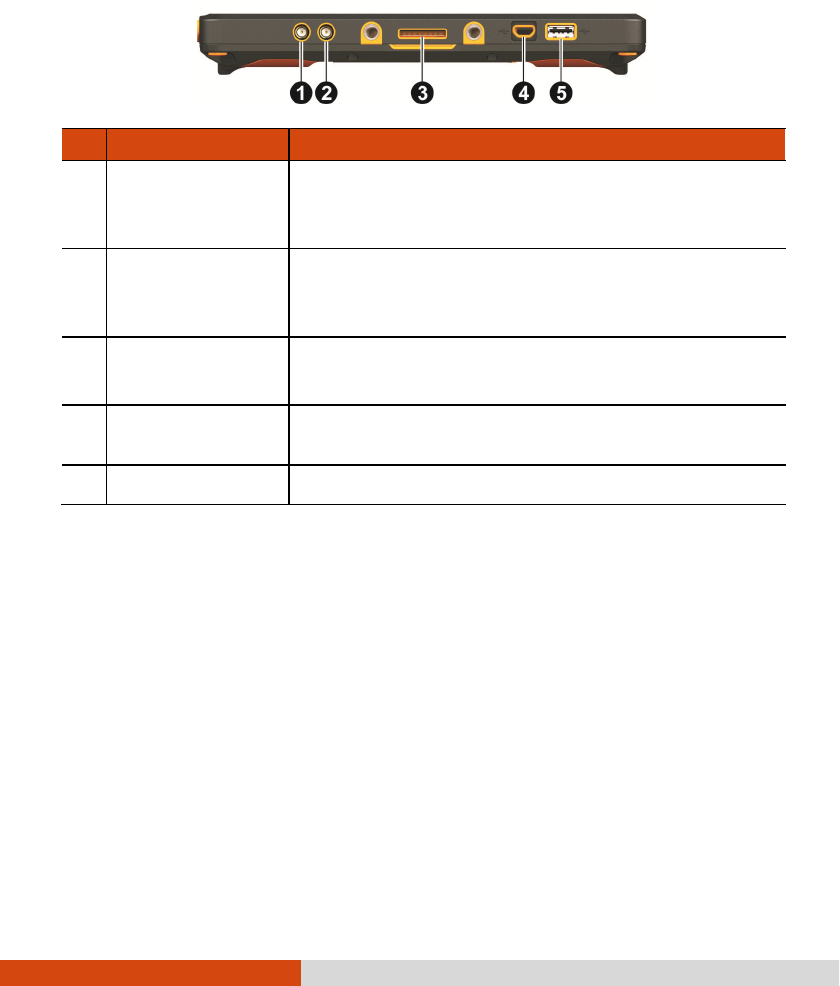
5
Bottom
BottomBottom
Bottom
Components
ComponentsComponents
Components
Ref
RefRef
Ref
Component
ComponentComponent
Component
Description
DescriptionDescription
Description
WWAN
WWAN WWAN
WWAN p
pp
pass
assass
ass-
--
-
through
through through
through c
cc
connector
onnectoronnector
onnector
(optional)
Connects the external antenna for WWAN (
wireless wide
area network) connectivity.
GPS
GPS GPS
GPS p
pp
pass
assass
ass-
--
-through
through through
through
c
cc
connector
onnectoronnector
onnector
(optional)
Connects the external antenna for GPS signal reception.
Docking
Docking Docking
Docking c
cc
connector
onnectoronnector
onnector
Connects to the office or vehicle dock (purchased
separately).
Micro
Micro Micro
Micro USB
USB USB
USB client
client client
client
c
cc
connector
onnectoronnector
onnector
Connects to a computer via USB cable for data transfer.
USB
USB USB
USB host
host host
host c
cc
connector
onnectoronnector
onnector
Connects to a USB device.
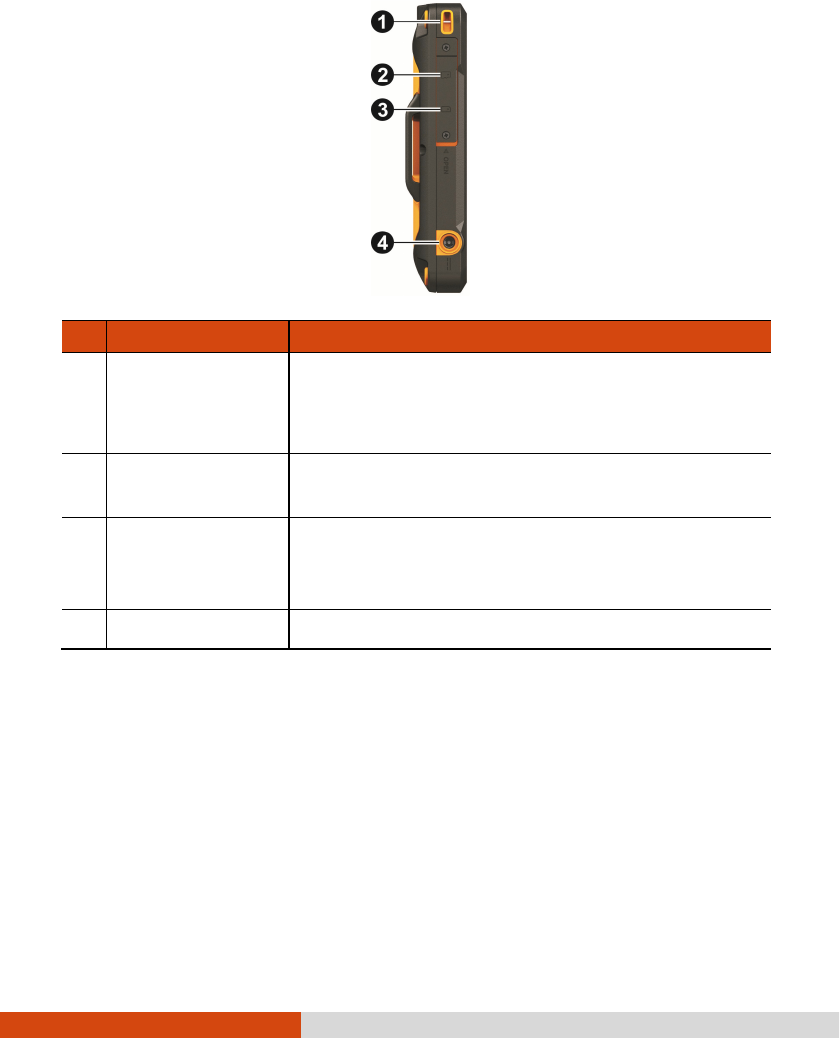
6
Left
LeftLeft
Left-
--
-Side
SideSide
Side
Components
ComponentsComponents
Components
Ref
RefRef
Ref
Component
ComponentComponent
Component
Description
DescriptionDescription
Description
Tether
Tether Tether
Tether h
hh
holder
olderolder
older
For holding a tether.
There is one holder on the left side and another on
the right side.
MicroSD card slot
MicroSD card slotMicroSD card slot
MicroSD card slot
(inside the cover)
Accepts a microSD card for removable storage.
SIM card slot
SIM card slot SIM card slot
SIM card slot
(optional) (inside
the cover)
Accepts a SIM card for the WWAN function.
Power Connector
Power ConnectorPower Connector
Power Connector
Connects to the AC adapter.
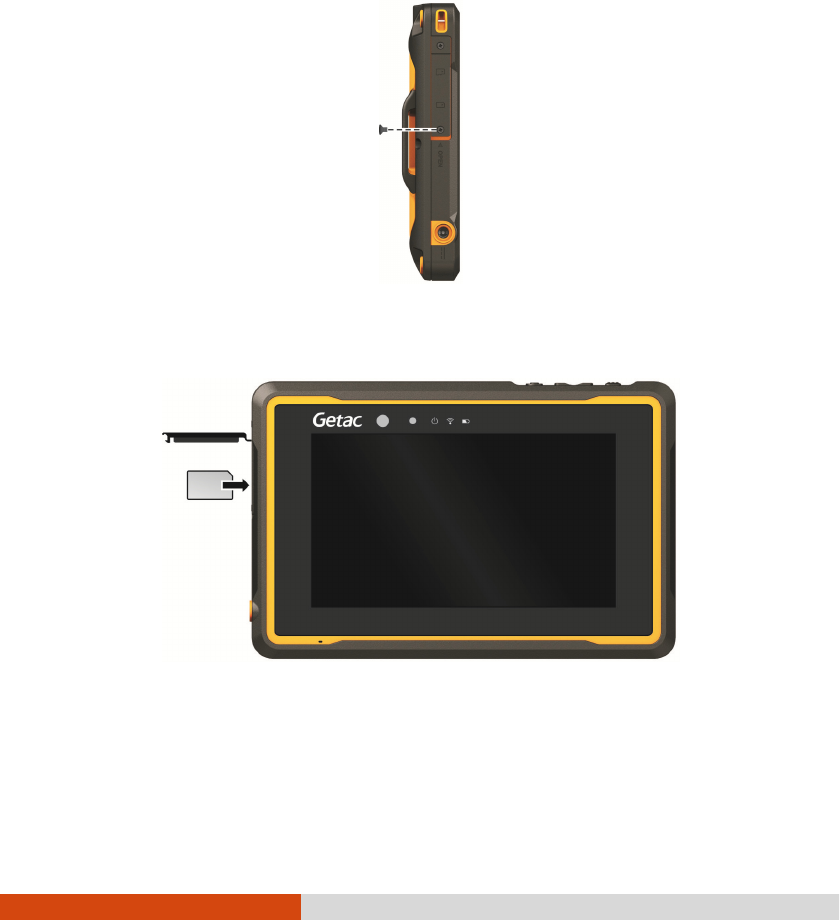
7
Getting Your Device Ready for
Getting Your Device Ready for Getting Your Device Ready for
Getting Your Device Ready for Use
UseUse
Use
Installing the SIM Card (Select Models Only)
Installing the SIM Card (Select Models Only)Installing the SIM Card (Select Models Only)
Installing the SIM Card (Select Models Only)
1. Remove the screw from the I/O cover and flip open the cover.
2. With the SIM card’s chip side facing the back of the device and the beveled corner
pointing to the slot, insert the card all the way into the slot.
NOTE: To remove the SIM card, slightly push in the card to
release it and then pull the card out of the slot.
3. Close the cover and tighten the screw.
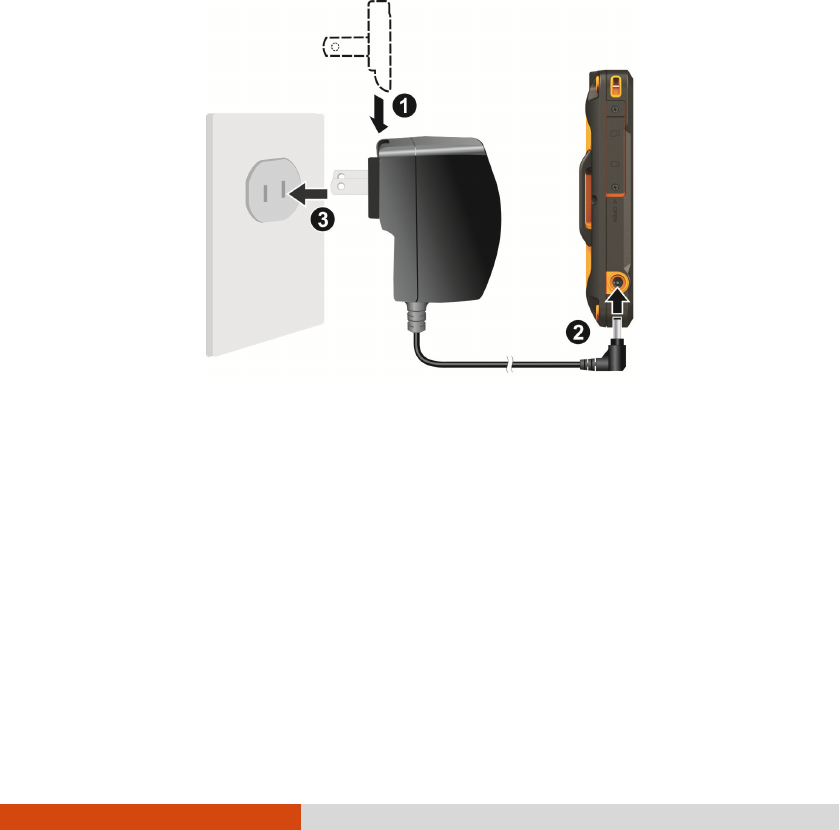
8
CAUTION: For protection, make sure you secure the cover with
the screw.
Connecting to AC Power
Connecting to AC PowerConnecting to AC Power
Connecting to AC Power
and Charging the Bat
and Charging the Batand Charging the Bat
and Charging the Battery
terytery
tery
1. Fit the converter plug to the AC adapter (
).
2. Connect the DC jack end of the AC adapter to your device (
) and the other
end to a wall outlet (
).
3. The charge indicator glows in amber when charging is in progress. Do not
disconnect your device from AC power until the battery is fully charged, as
indicated by the amber indicator turning into green. This will take a couple of
hours.
CAUTION: For optimal performance of the lithium battery, take
note of the following:
Use the included AC adapter only.
There is no need to fully discharge the battery before
charging. You can charge the battery before it is discharged.
Do not charge the battery where the temperature is high (e.g.
in direct sunlight).
Converter Plug

9
As a battery protection, store the device where the
temperature is appropriate. Avoid high temperatures.
The battery can be charged when its temperature is between
0°C (32°F) and 40°C (104°F).
If you will not use the product for a long period of time,
be sure to fully charge the battery at least once
every two weeks. Over discharge of the battery can affect
the charging performance.
Performing
Performing Performing
Performing the
the the
the Initial Startup
Initial StartupInitial Startup
Initial Startup
When turning on your device for the very first time, you will be guided through
a setup process.
1. Make sure that your device is either connected to AC power or the battery has
power.
2. Press the power button.
The device powers up and displays the initial screen.
3. Follow the on-screen instructions to complete the initial setup process.
After the setup is completed, the Home screen appears. You can now use your
device.

10
Chapter 2
Chapter 2Chapter 2
Chapter 2
Basic Skills
Basic SkillsBasic Skills
Basic Skills
This chapter familiarizes you with the basic operations of your device.
CAUTION: The device can get uncomfortably warm when you use it in
high temperatures. In such a circumstance, please take safety
measures (such as wearing gloves) to protect yourself.
Prolonged body contact can cause discomfort and potentially a
burn.
Waking Up and Shutting Down
Waking Up and Shutting DownWaking Up and Shutting Down
Waking Up and Shutting Down
Your device sleeps after a period of inactivity. To wake up, press the power button
and, at the lock screen, drag the lock icon to the other side of the screen.
To shut down, press and hold the power button until a menu pops up. Touch Power
Power Power
Power
off
offoff
off and then OK
OKOK
OK.
Navigating on the
Navigating on the Navigating on the
Navigating on the S
SS
Screen
creencreen
creen
Use your finger to navigate and select objects on the screen.
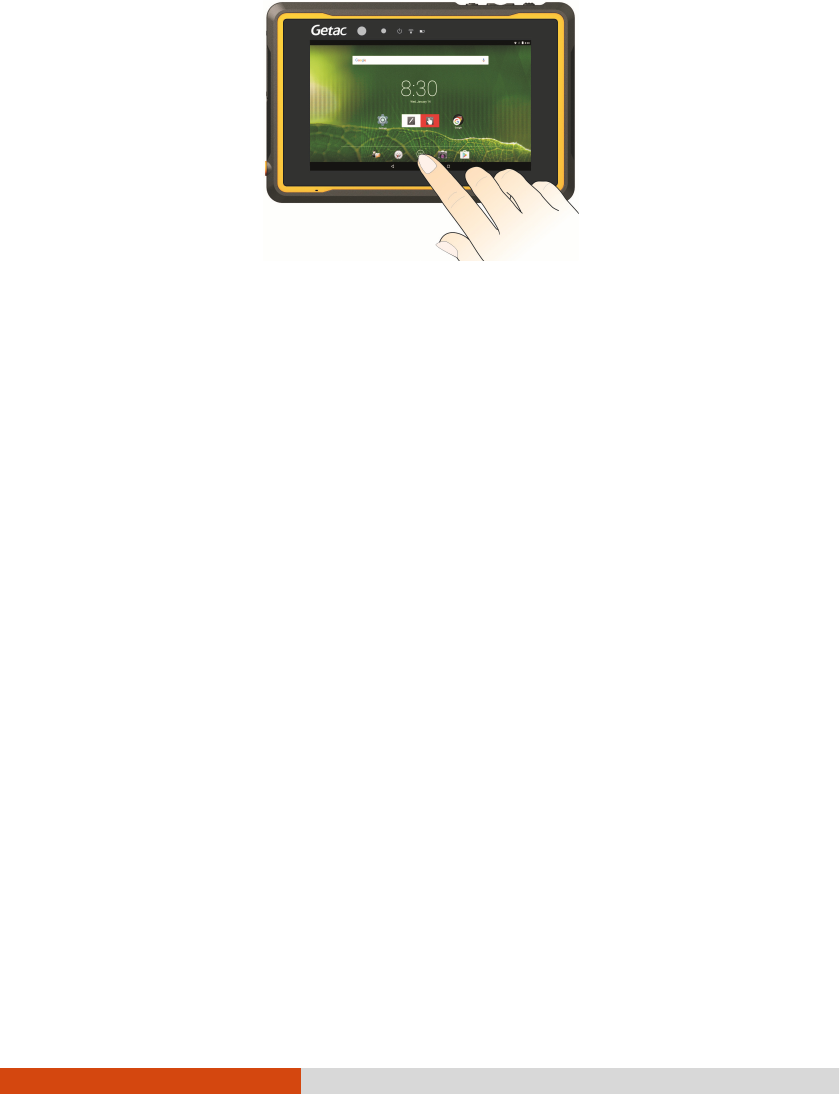
11
Here are some common terms that you should know when using the touch screen:
Touch
TouchTouch
Touch
Touch the screen once with your finger to open an item or select an object.
Touch
TouchTouch
Touch
and hold
and holdand hold
and hold
Touch and hold your finger on an item to see a list of actions available for
that item.
Drag
DragDrag
Drag
Hold your finger on an item and, without lifting the finger, move across the
screen until you reach the target position.
Swipe or slide
Move your finger across the screen, without pausing when you first touch it
(so you don’t “drag” instead). For example, you slide the screen up or down
to scroll a list.
Pinch
In some applications (such as Maps and Gallery), you can zoom in and out
by placing two fingers on the screen at once and pinching them together (to
zoom out) or spreading them apart (to zoom in).
CAUTION: Do not use sharp objects on the touch screen. Doing
so may damage the display surface.
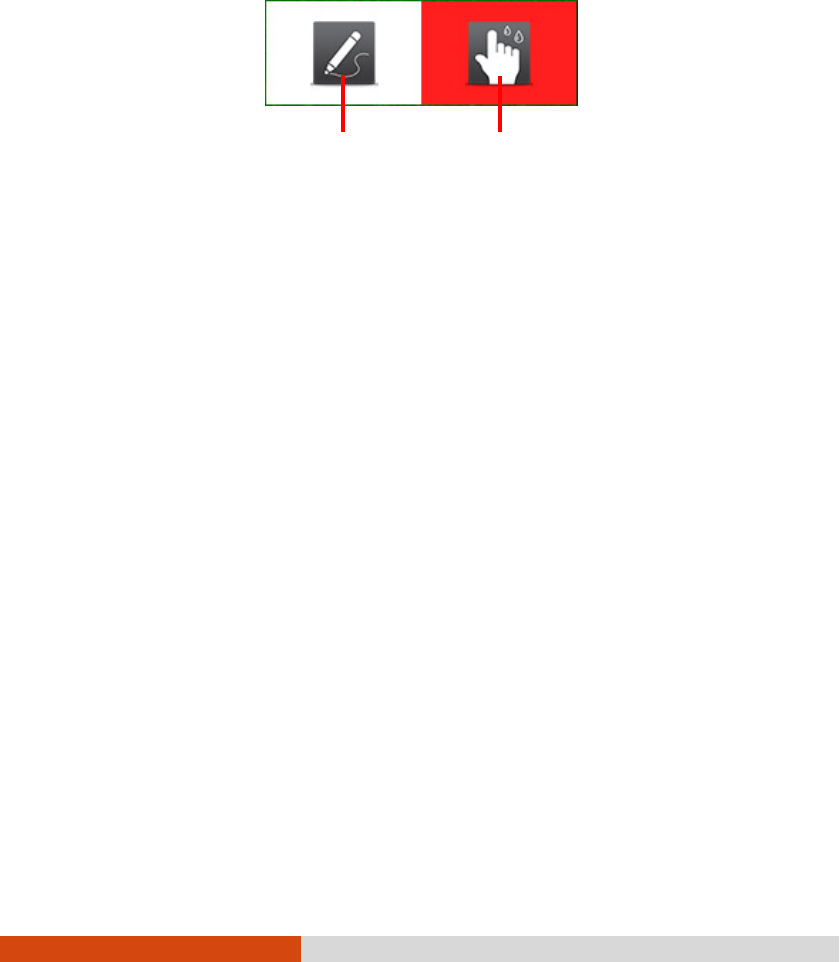
12
Touch Mode
Touch ModeTouch Mode
Touch Mode
You can change the touch mode to suit your scenario. To quickly switch the mode,
touch one of the widgets on the Home screen.
NOTE: The stylus should be a capacitive-tipped stylus (purchased
separately).
A
AA
Auto Rotate
uto Rotateuto Rotate
uto Rotate
The display orientation changes automatically when you rotate the device. You can
disable the function through Settings.
Home Screen
Home ScreenHome Screen
Home Screen
The Home screen is your starting point to access all the features on your device.
You can have it display application icons, widgets, shortcuts, and other features
that you want. The default Home screen already contains some application icons
and widgets. At the bottom of every Home screen is the Favorites tray.
Select this if you are using the
stylus. This mode responds to
finger touch
es as well.
Select this when liquids
(such as
raindrops) are falling on the screen
and should be rejected as input.
Use your finger in this mode.
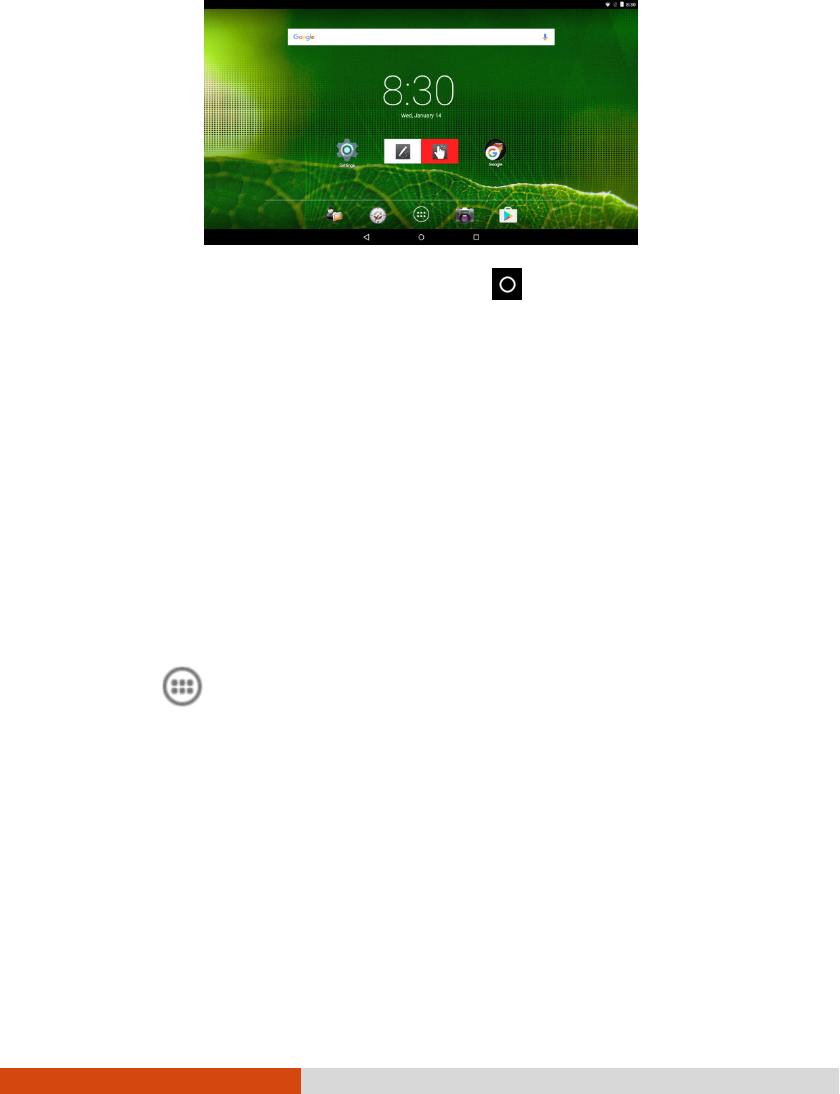
13
To return to the Home screen at any time, touch at the bottom of the screen.
Extensions to the Home Screen
Extensions to the Home ScreenExtensions to the Home Screen
Extensions to the Home Screen
You can slide left or right across the Home screen to see other parts of the Home
screen. Extensions to the Home screen provide more space for widgets, shortcuts,
and other items.
Customizing Your Home Screen
Customizing Your Home ScreenCustomizing Your Home Screen
Customizing Your Home Screen
You can add application icons, shortcuts, widgets, and other items to any part of
the Home screen where there’s free space. You can also change the wallpaper.
A
AA
Ad
dd
dding an Item to the Home Screen
ding an Item to the Home Screending an Item to the Home Screen
ding an Item to the Home Screen
1. Touch on the Home screen.
2. Touch APPS or WIDGETS depending on the type of item you want to add.
3. Touch and hold an item to add. Drag it to the where you want to place it
and then release it.
Removing an Item from the Home Screen
Removing an Item from the Home ScreenRemoving an Item from the Home Screen
Removing an Item from the Home Screen
Touch and hold the item you want to remove. Drag it to the X icon at the top
of the screen.
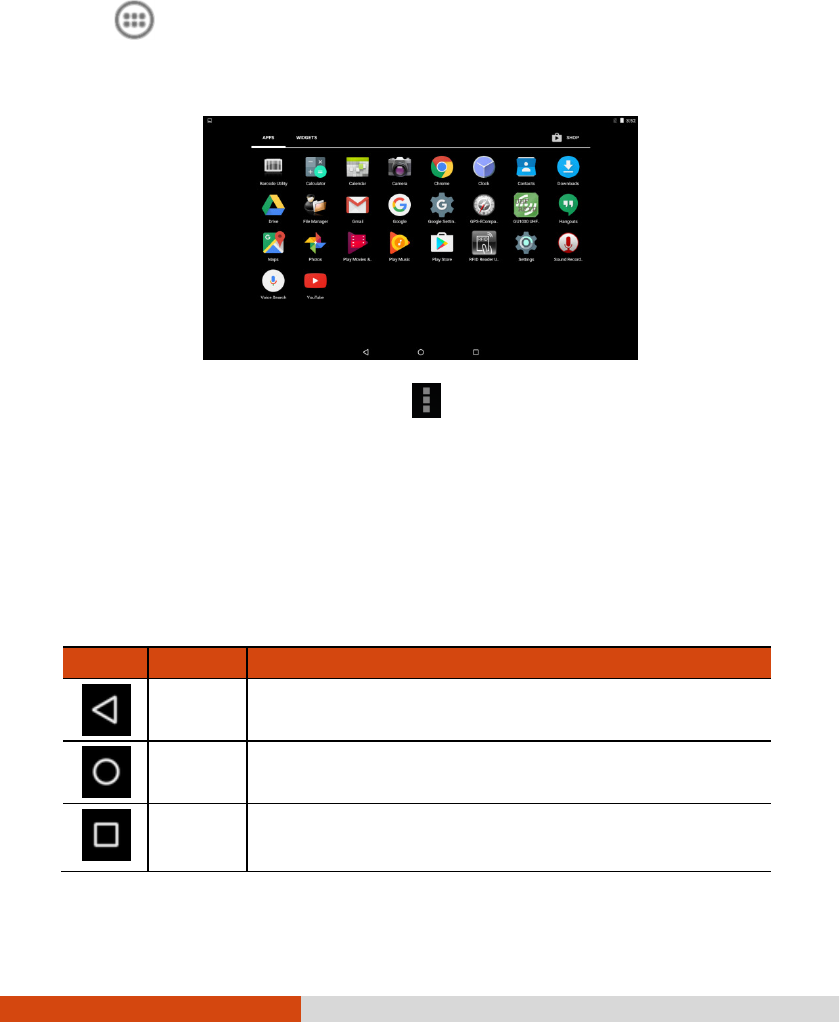
14
U
UU
Using Applications
sing Applicationssing Applications
sing Applications
Touch (in the Favorites tray) on the Home screen to open the All Apps screen.
The screen holds icons for all of the applications on your device. Touch an icon
to open the application.
Most applications include a Menu icon near the top or lower right corner of
the screen. The menu contains tools that apply to the activities of the current screen
or application.
Navigation Bar
Navigation BarNavigation Bar
Navigation Bar
The navigation bar at the bottom of the screen provides buttons for navigation purposes
and frequently-used tasks.
Button
ButtonButton
Button
Name
NameName
Name
Description
DescriptionDescription
Description
Back Goes back to the previous screen.
Home Opens the Home screen.
Recent Opens a screen containing
thumbnails of applications you’ve
used recently. Touch a thumbnail to open that application.
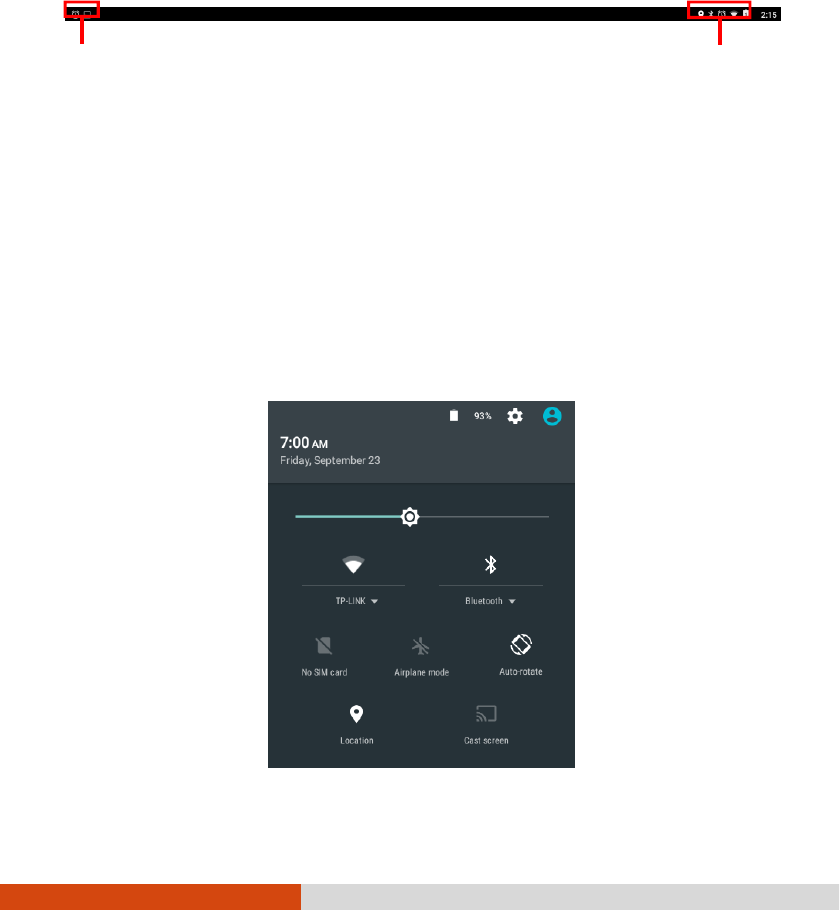
15
Status Bar
Status BarStatus Bar
Status Bar
and Notifications Panel
and Notifications Paneland Notifications Panel
and Notifications Panel
The Status bar appears at the top of almost every screen. It displays icons indicating
that you’ve received notifications (on the left) and icons indicating the current status
(on the right), along with the current time.
You can open the Notifications panel by swiping down from the top.
Quick Settings
Quick SettingsQuick Settings
Quick Settings
Use Quick Settings to quickly change common settings such as screen brightness,
Wi-Fi, Bluetooth, Airplane mode, and others.
You can open Quick Settings from anywhere on your device. Swipe down from the
top to open the Notifications panel and swipe down again to open the Quick Settings
panel.
Status icons
N
otifications
icons

16
Entering
Entering Entering
Entering Information
InformationInformation
Information
You enter text, numbers, and symbols using the onscreen keyboard. Some
applications open the keyboard automatically. In others, you touch an input field where
you want to enter text to open the keyboard.
To enter text, touch the keys on the keyboard to type. To enter numbers or symbols,
touch the Symbols key to switch to the numbers and symbols keyboard.

17
Chapter 3
Chapter 3Chapter 3
Chapter 3
Getting Connected
Getting ConnectedGetting Connected
Getting Connected
This chapter tells you how you can get your device connected through a variety
of ways.
Wireless Connections
Wireless ConnectionsWireless Connections
Wireless Connections
Using
Using Using
Using W
WW
WWAN
WAN WAN
WAN (Select Models Only)
(Select Models Only)(Select Models Only)
(Select Models Only)
NOTE: Your model only supports data transmission. Voice
transmission is not supported
Select models support UMTS/HSPA+/GSM/GPRS/EDGE) mobile telephony
communications protocol.
Mobile network is enabled by default. The icons in the Status bar indicate which
kind of data network you’re connected to and the voice and data network signal
strength.
To check or modify settings, touch (on the Home screen) Settings
SettingsSettings
Settings
More (under WIRELESS & NETWORKS) Mobile networks.
Usi
UsiUsi
Usin
nn
ng
g g
g Wi
WiWi
Wi-
--
-Fi
FiFi
Fi
Networks
NetworksNetworks
Networks
Turn
TurnTurn
Turning
ing ing
ing On/Off the Wi
On/Off the WiOn/Off the Wi
On/Off the Wi-
--
-Fi Radio
Fi RadioFi Radio
Fi Radio
Go to Quick Settings and touch the Wi-Fi icon.
- Or –
Go to Settings. Find the Wi-Fi item under WIRELESS & NETWORKS. Slide the Wi-Fi
switch on or off.

18
When the Wi-Fi radio is turned on, the icon appears in the status bar. If your
device finds a network that you connected to previously, it connects to it.
Connecting to
Connecting toConnecting to
Connecting to
a
a a
a Wi
WiWi
Wi-
--
-Fi
FiFi
Fi
N
NN
Network
etworketwork
etwork
1. Make sure the Wi-Fi radio is on (as described in the previous section).
2. Go to Quick Settings and touch the down arrow of the Wi-Fi item.
- Or -
Go to Settings. Touch Wi-Fi.
3. Your device scans for available Wi-Fi networks and displays the names in the
screen.
4. On the list of discovered networks, touch the one you want to connect to.
5. If the network is secured, you’re prompted to enter a password or other
credentials.
If the network is open, you are prompted to confirm that you want to connect
to that network by touching Connect
ConnectConnect
Connect
Using the Bluetooth
Using the Bluetooth Using the Bluetooth
Using the Bluetooth F
FF
Function
unctionunction
unction
NOTE: Getac does not guarantee the product’s compatibilities
with the Bluetooth headsets/devices from all manufacturers.
Turn
TurnTurn
Turning
ing ing
ing On/Off the
On/Off the On/Off the
On/Off the Bluetooth
Bluetooth Bluetooth
Bluetooth Radio
RadioRadio
Radio
Go to Quick Settings and touch the Bluetooth icon.
- Or –
Go to Settings. Find the Bluetooth item under WIRELESS & NETWORKS. Slide the
Bluetooth switch on or off.
When the Bluetooth radio is turned on, the icon appears in the status bar.

19
Pairing with
Pairing withPairing with
Pairing with
a Bluetooth
a Bluetooth a Bluetooth
a Bluetooth Device
DeviceDevice
Device
The first time you use a new Bluetooth device with your device, you must “pair”
them, so that they know how to connect securely to each other. After that, you
can simply connect to a paired device.
1. Make sure that the other Bluetooth device is set as “discoverable” and within
range.
2. Make sure the Bluetooth radio is on (as described in the previous section).
3. Go to Quick Settings and touch the down arrow of the Bluetooth item.
- Or -
Go to Settings. Touch Bluetooth.
4. Your device scans for and displays the IDs of all available Bluetooth devices
in range.
5. On the list of discovered devices, touch the ID of the device you want to pair
with.
6. The devices pair with each other. If you’re prompted to enter a passcode, try
entering 0000 or 1234 (the most common passcodes), or consult the
documentation that came with the device to learn its passcode.
If the pairing is successful, your device connects to the device.
External Connections
External ConnectionsExternal Connections
External Connections
Using a MicroSD Card
Using a MicroSD CardUsing a MicroSD Card
Using a MicroSD Card
Inserting a MicroSD Card
Inserting a MicroSD CardInserting a MicroSD Card
Inserting a MicroSD Card
1. Remove the screw from the I/O cover and flip open the cover.
2. Insert the card into the slot, with the golden contacts pointing to the slot and
facing front.
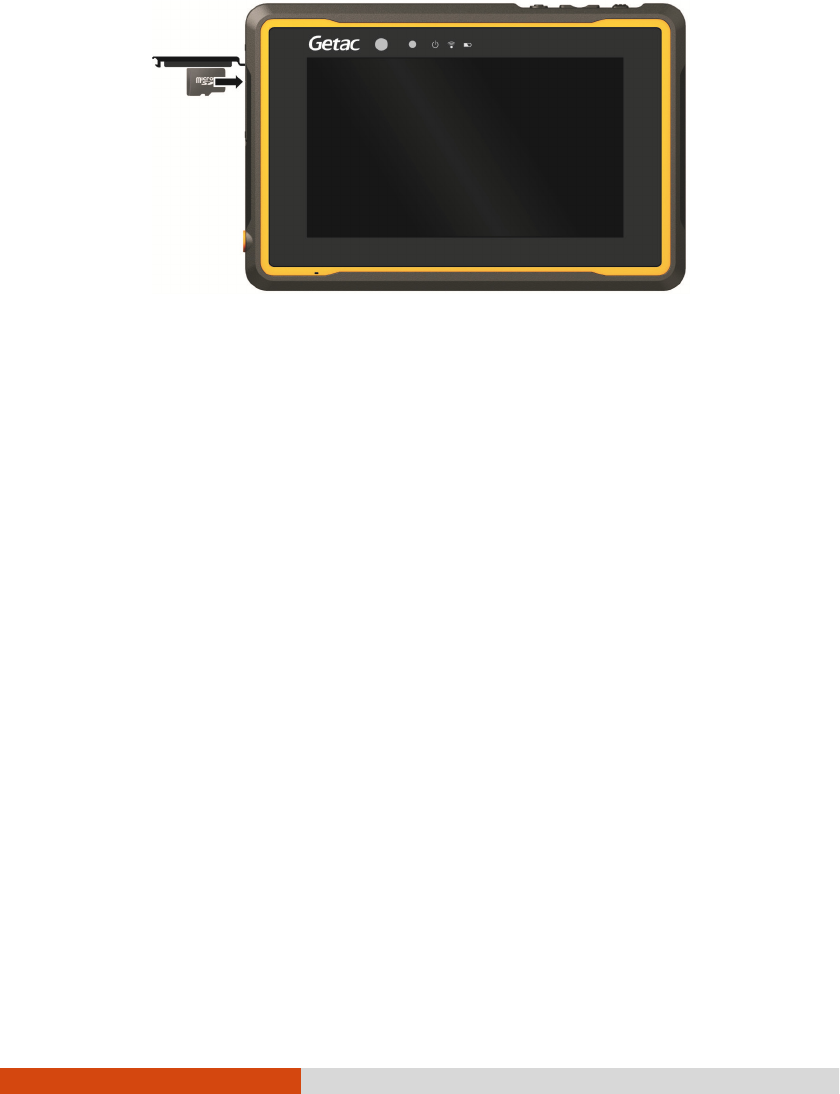
20
3. Close the cover and tighten the screw.
CAUTION: For protection, make sure you secure the cover with
the screw.
Removing MicroSD card
Removing MicroSD cardRemoving MicroSD card
Removing MicroSD card
You can safely remove the microSD card from your device any time the device
is shut down. If you need to remove the card while the device is on, unmount
the card first to prevent corrupting or damaging the card.
To unmount:
1. Go to Settings
SettingsSettings
Settings.
2. Touch
Storage
StorageStorage
Storage and touch Unmount SD card
Unmount SD cardUnmount SD card
Unmount SD card under EXTERNAL SD CARD
EXTERNAL SD CARDEXTERNAL SD CARD
EXTERNAL SD CARD.
3. Open the microSD card slot cover. Press the edge of the card to release it
and then pull the card out of the slot.
Connecting to a
Connecting to a Connecting to a
Connecting to a C
CC
Computer via USB
omputer via USBomputer via USB
omputer via USB
You can connect your device to a computer with the USB cable, to transfer files
between your device and the computer.
Use the USB cable (available to you as an option) to connect the device to a
USB port on your computer.
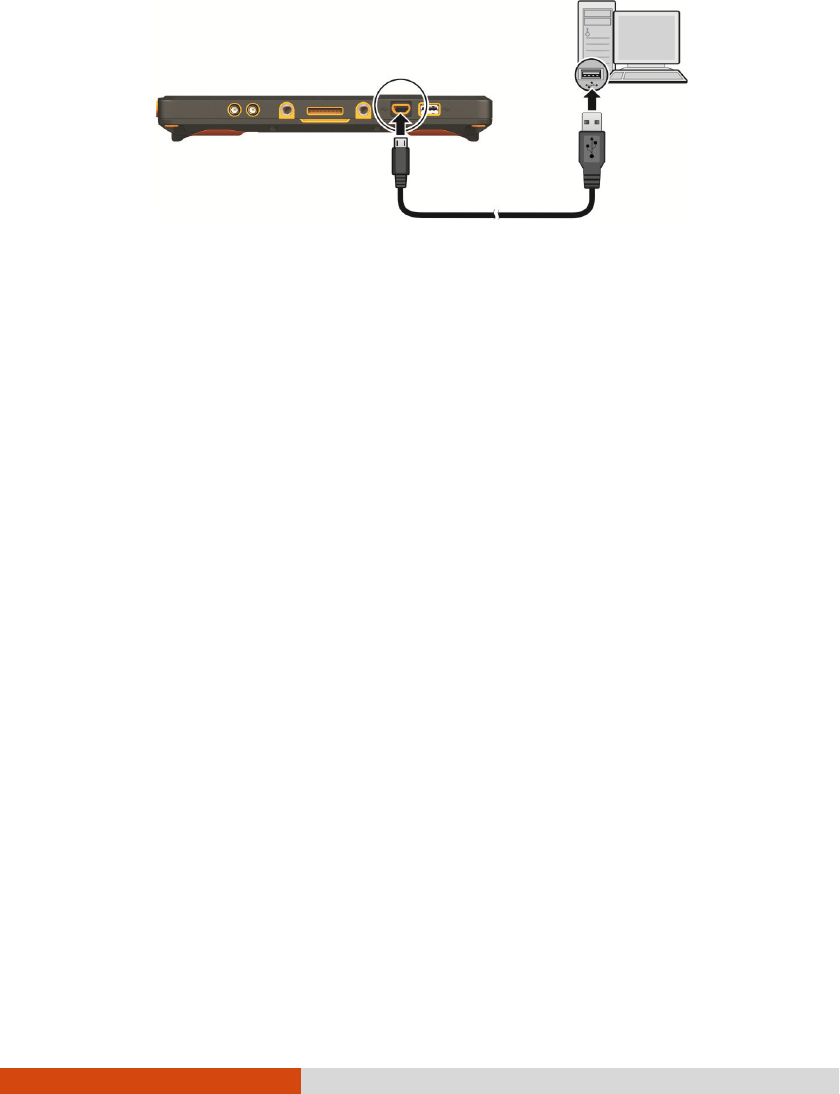
21
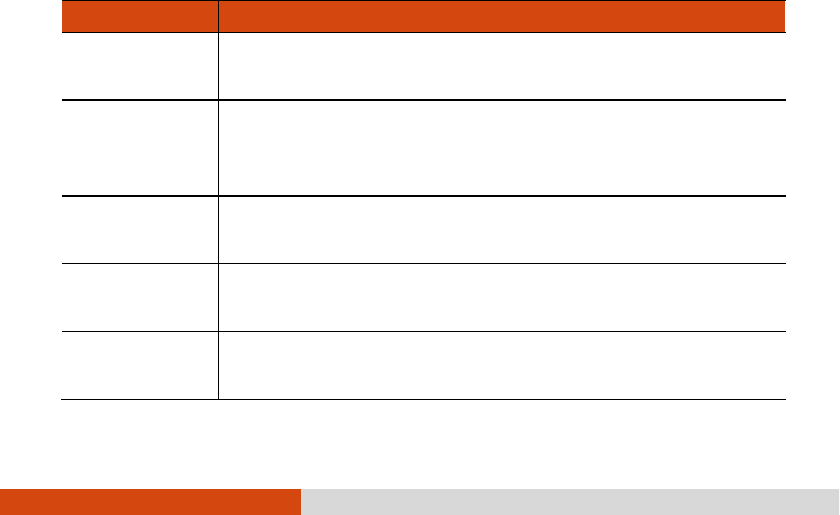
22
Chapter 4
Chapter 4Chapter 4
Chapter 4
Android Preinstalled
Android Preinstalled Android Preinstalled
Android Preinstalled
Applications
ApplicationsApplications
Applications
This chapter briefly introduces the Android 5.1.1 preinstalled applications from Google.
Google
Google Google
Google Applications
ApplicationsApplications
Applications
Overview
OverviewOverview
Overview
For instructions on using the Google applications, check Google official website for
online help.
NOTE: The table below does not include Getac applications. See
the next chapter for information on Getac applications.
Apps
AppsApps
Apps
Descriptions
DescriptionsDescriptions
Descriptions
Calculator Use Calculator to solve arithmetic problems. You can t
hen paste
the results into another application.
Calendar The Calendar app works with the web-based Google Calendar
calendaring service. It also works with the Microsoft Exchange
ActiveSync calendaring service.
Camera Use Camera to take pictures and shoot videos. (See “Camera”
later in this chapter for more information.)
Chrome This is the web browser from Google
. Sign in to sync your Chrome
browser experience from your computer
Clock Use Clock to display the
date and time in large characters on
your screen.
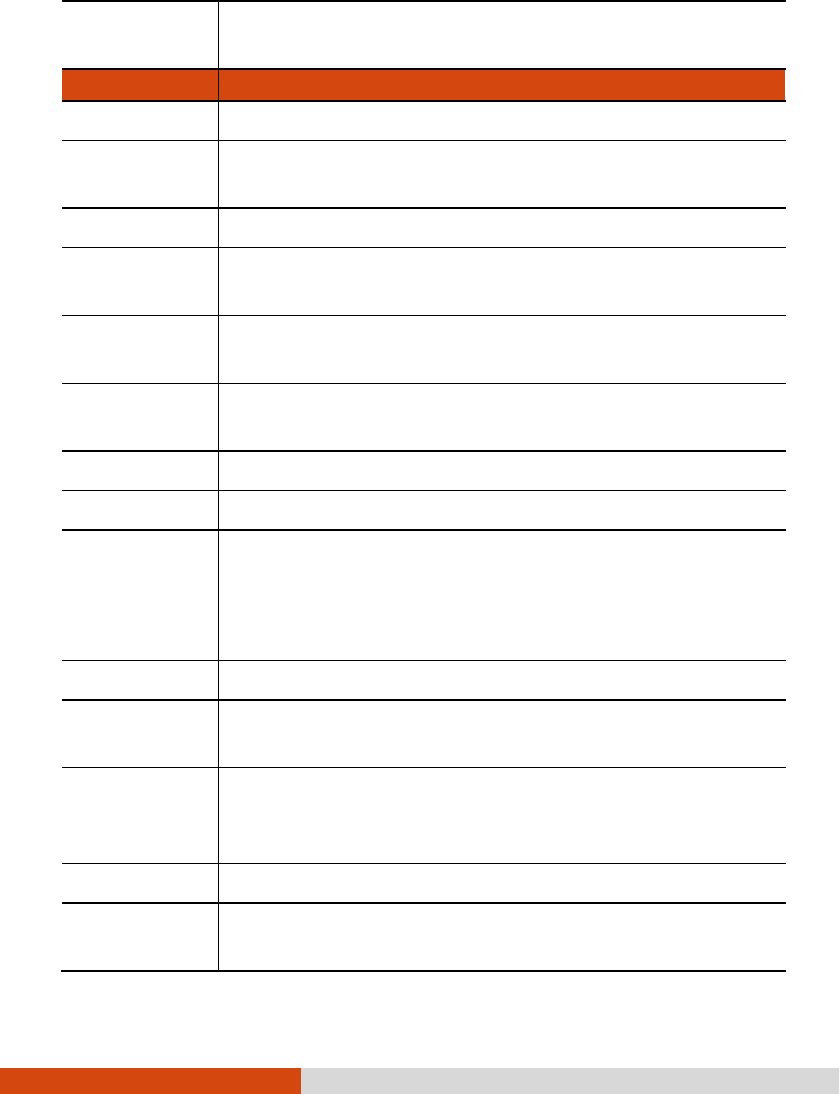
23
Contacts The Contacts app
gives you quick and easy access to the people
you want to reach.
Apps
AppsApps
Apps
Descriptions
DescriptionsDescriptions
Descriptions
Downloads The Downloads app lets you to manage most downloads.
Drive Use Drive to store your files securely in the cloud
and also to
access them.
Gmail Gmail works with Google’s web-based email service.
Google Use Google to easily and quickly
find what you need on the web
and on your device.
Google Settings Use Google Settings to manage se
ttings for Google apps and
services.
Hangouts U
se Hangouts to send messages, make voice and video calls,
and share photos.
Maps This is the Google Maps app for Android.
Photos Use Photos to manage photos and videos on your device.
Play Movies & TV
Shows
You can play digital content through the service of Google.
However, the availability of the service depends on your
geographical location. The app icons will disappear
from the screen
if you are in a region where the service is currently unavailable.
Play Music Use Play Music to organize and listen to music and audio files.
Play Store Use Play Store to get all your applications and
entertainment in
one place.
Settings
The Settings app contains most of the tools for customizing and
configuring your device. (See “Settings”
in Chapter 7 for more
information.)
Sound Record This is a tool for recording sound.
Voice Search Use Voice Search to quickly search your device
, the web, and
nearby locations by speaking, instead of typing.
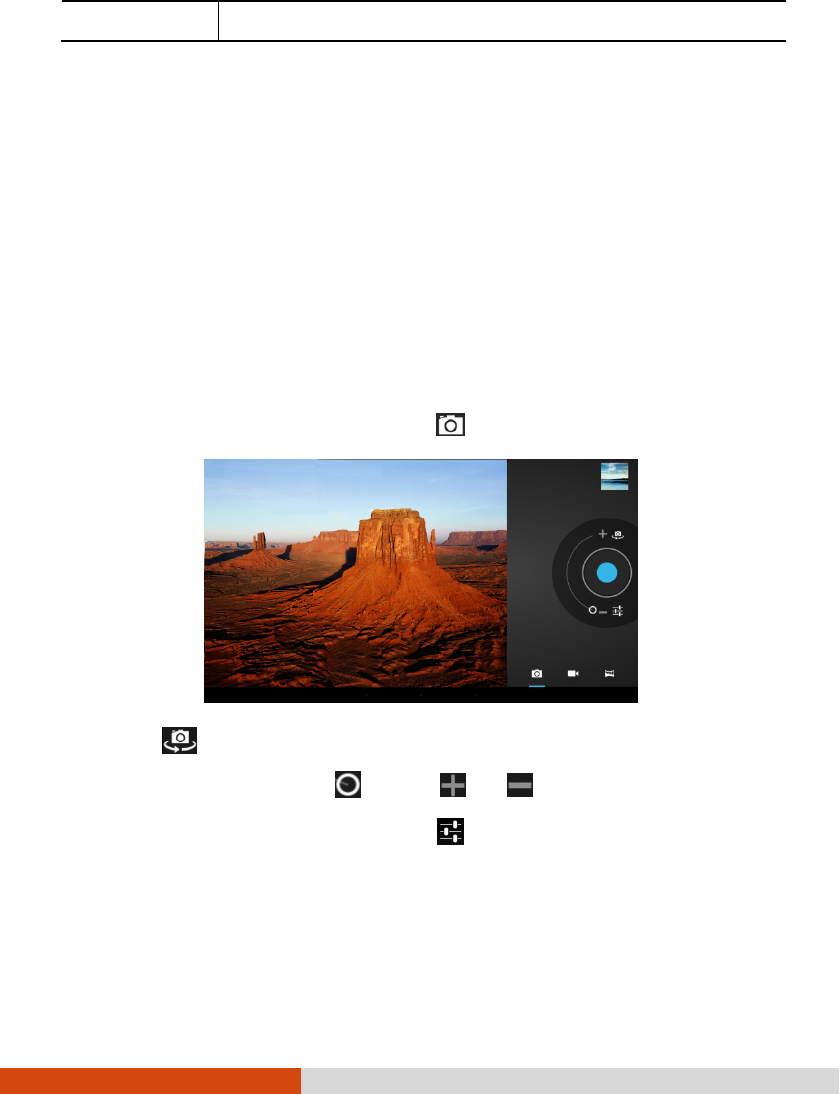
24
YouTube This is the official YouTube app for Android.
Camera
CameraCamera
Camera
Use the Camera application to take pictures and shoot videos. In addition, you can
have GPS information embedded into the picture/video file.
Taking Pictures
Taking PicturesTaking Pictures
Taking Pictures
1. Open the Camera application. Touch if you are not in Camera mode.
2. Touch to select the front or rear camera lens.
3. To zoom in or out, drag toward or .
4. If you want to adjust settings, touch .
Flash mode
(rear camera only)
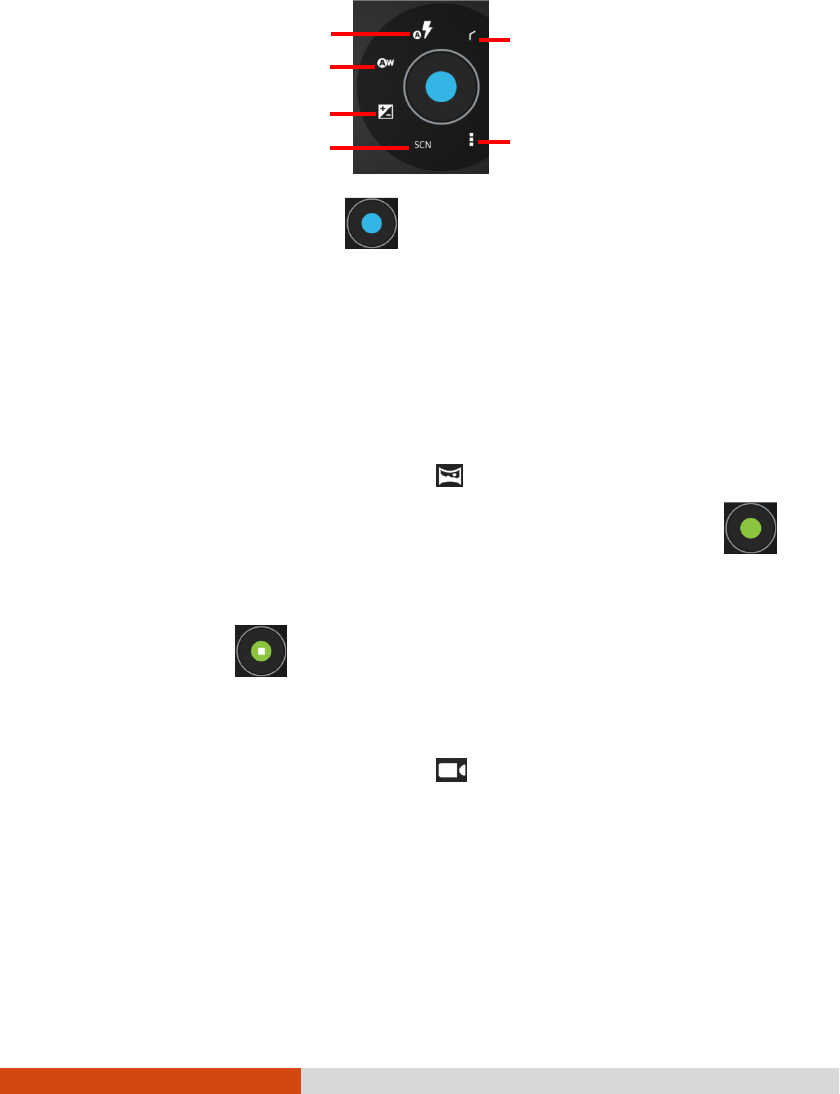
25
5. To take the picture, touch .
6. The picture you just took is displayed as a thumbnail at the corner. You can
touch the thumbnail to view the picture.
The file is saved to the internal storage of your device.
Taking Panoramic
Taking PanoramicTaking Panoramic
Taking Panoramic
Pictures
PicturesPictures
Pictures
1. Open the Camera application. Touch to switch to Panoramic mode.
2. Aim the camera lens at the starting point of the intended view. Touch
to start.
3. Slowly pan your device toward the other side. The status bar shows your progress.
4. To end, touch .
Shooting Videos
Shooting VideosShooting Videos
Shooting Videos
1. Open the Camera application. Touch to switch to Video mode.
Return
White balance
Exposure
Advanced settings
Scene mode
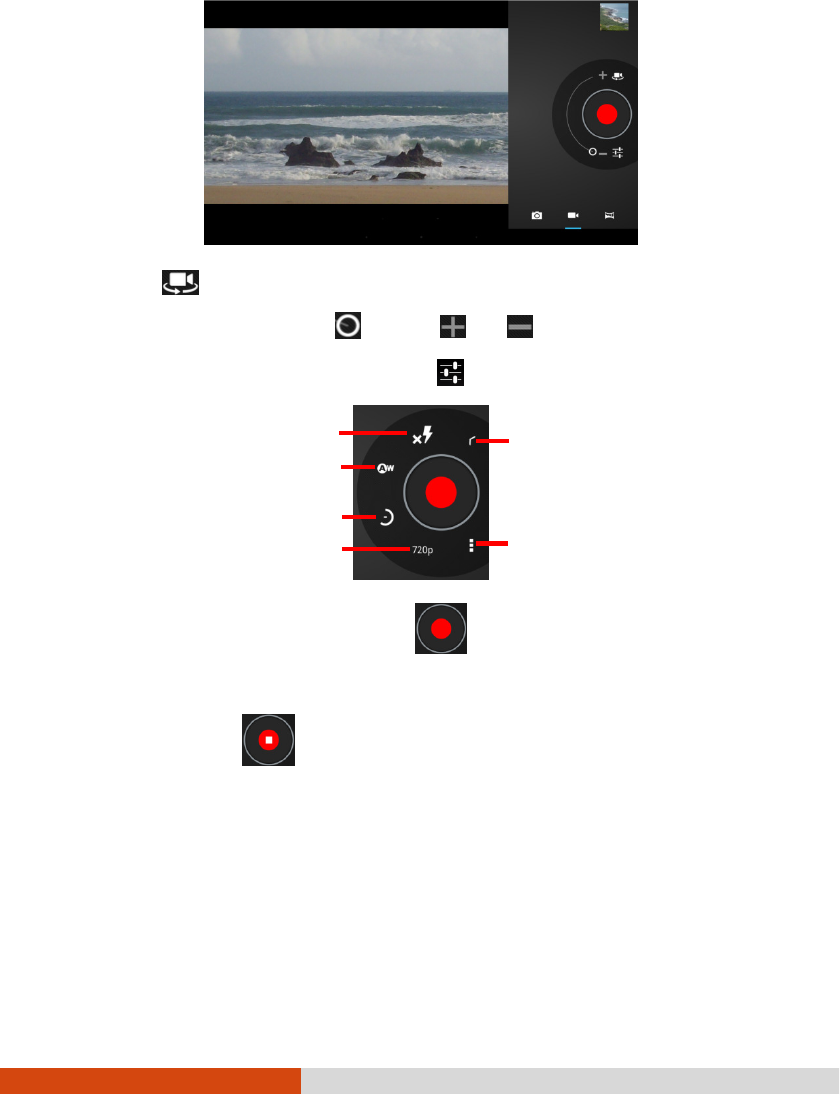
26
2. Touch to select the front or rear camera lens.
3. To zoom in or out, drag toward or .
4. If you want to adjust settings, touch .
5. To start shooting the video, touch .
The elapsed time shows at the corner.
6. To stop, touch .
7. An image from your most recent video is displayed as a thumbnail at the corner.
You can touch the thumbnail to view the video.
The file is saved to the internal storage of your device.
Return
White balance
Advanced settings
Time lapse interval
Video quality
Flash mode
(rear camera only)

27
Chapter 5
Chapter 5Chapter 5
Chapter 5
Getac
GetacGetac
Getac
Applications
ApplicationsApplications
Applications
This chapter describes the applications added by Getac for special features of your
device.
Barcode Utility and Configuration
Barcode Utility and Configuration Barcode Utility and Configuration
Barcode Utility and Configuration
(Select Models Only)
(Select Models Only)(Select Models Only)
(Select Models Only)
Barcode Utility
Barcode UtilityBarcode Utility
Barcode Utility
Barcode Utility is a demo application that can read barcodes of common 1D and
2D symbologies.
NOTE: For enhanced applications and customization of the barcode
reader, contact your authorized Getac dealer.
1. To configure barcode options, use Barcode Config as described in the next section.
2. Open the Barcode Utility application.
3. To scan one barcode at a time, touch Trigger. Or, press the Fn button on
your device. (The button is defined as Trigger by default.)
To scan continuously, touch Continuous.
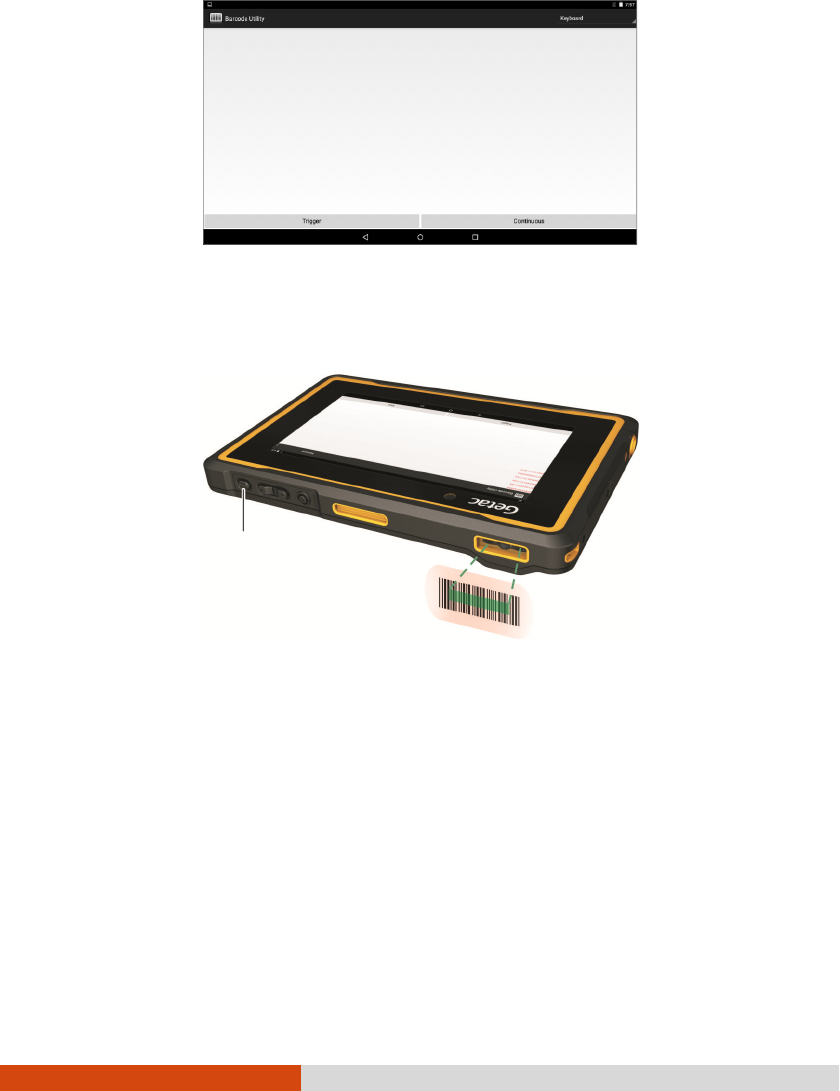
28
4. Aim the green scan beam so that it is centered over the barcode. Adjust the
lens’ distance from the barcode, shorter for a smaller barcode and farther for
a larger one.
NOTE: Improper ambient light and scanning angle can affect the
scanning results.
5. Upon a successful scan, the system beeps and the scan beam turns off. The
decoded barcode data will be entered.
If you are in continuous scanning mode, the scan beam turns back on again
for the next barcode. To stop scanning, touch Stop.
Trigger button
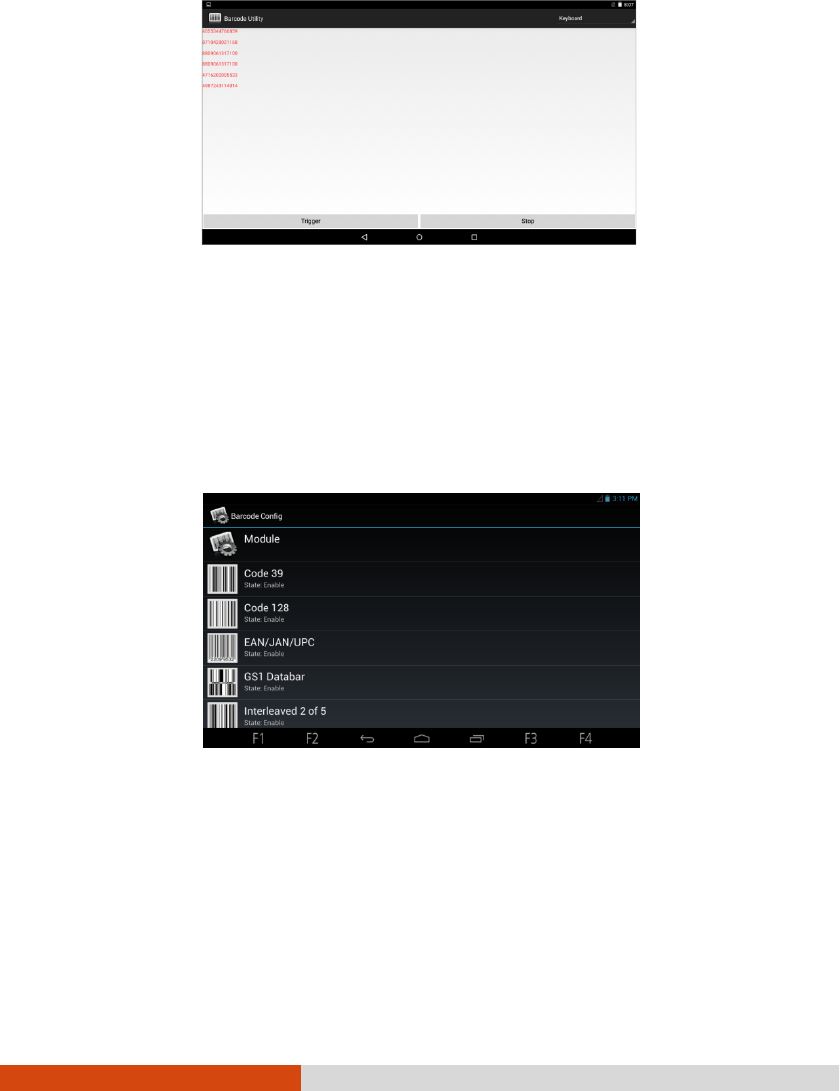
29
NOTE: The scan beam also turns off after timeout.
Barcode Config
Barcode ConfigBarcode Config
Barcode Config
Barcode Config allows you to configure options specific to individual barcode
symbologies.
1. Open the Barcode Config application.
2. Touch the name of a symbology to configure. You can enable or disable the
individual symbology and configure the options as needed.
To restore default settings or enable all symbologies, touch Module.
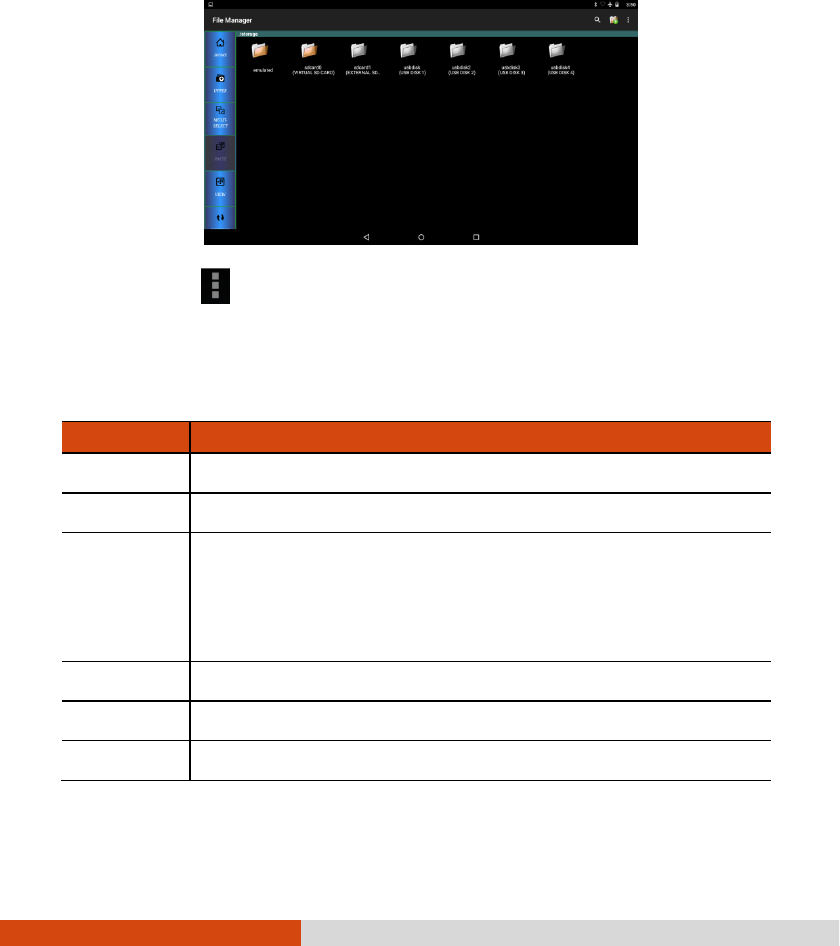
30
File Manager
File ManagerFile Manager
File Manager
File Manager allows you to organize your data in the internal SD card and any
connected external storage (such as a microSD card or USB disk).
To exit, touch Exit.
Button
Button Button
Button Descriptions
DescriptionsDescriptions
Descriptions
Left side buttons:
Buttons
ButtonsButtons
Buttons
Descriptions
DescriptionsDescriptions
Descriptions
Home Goes to the root directory.
Upper Goes one level up to the parent directory.
Multi-Select Enables or disables multiple selections.
When enabled, you can touch multiple files or folders for one batch
operation. A set of buttons appear on the left side of the screen
for you to use.
Paste Pastes what you have cut or copied to the current directory.
View Switches between icon and list view.
Refresh Refreshes the current directory.
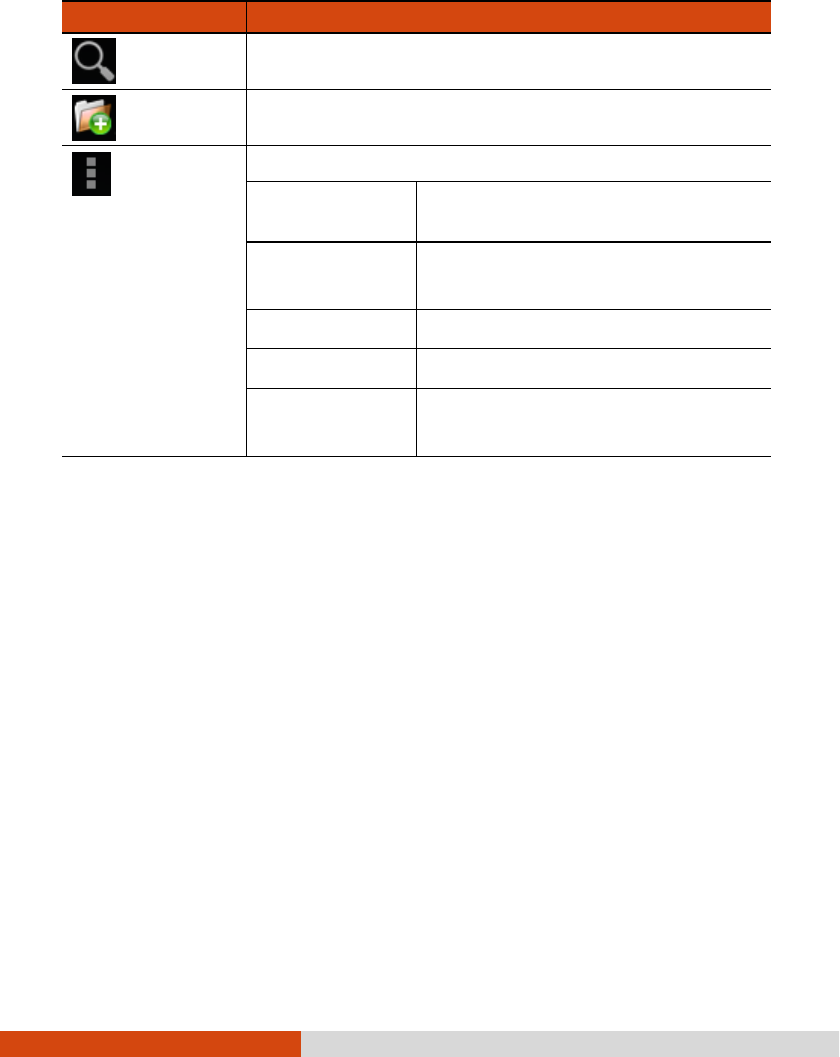
31
Upper-right buttons:
Buttons
ButtonsButtons
Buttons
Descriptions
DescriptionsDescriptions
Descriptions
Search Opens the Search box.
Add Folder Adds a folder in the current directory.
Menu Settings
Show all
files/directories
Check to show all files/directories.
Show image
thumbnail(s)
Check to have images shown as
thumbnails.
Display type Sets the view to icon or list view.
Sort by Specifies the sorting order.
Home directory
setting
Specifies a folder as the home directory
in File Manager.
Opening a File
Opening a FileOpening a File
Opening a File
When you touch a filename, File Manager tries to open or execute the file depending
on the file type.
NOTE: Not all files can be opened in this way.
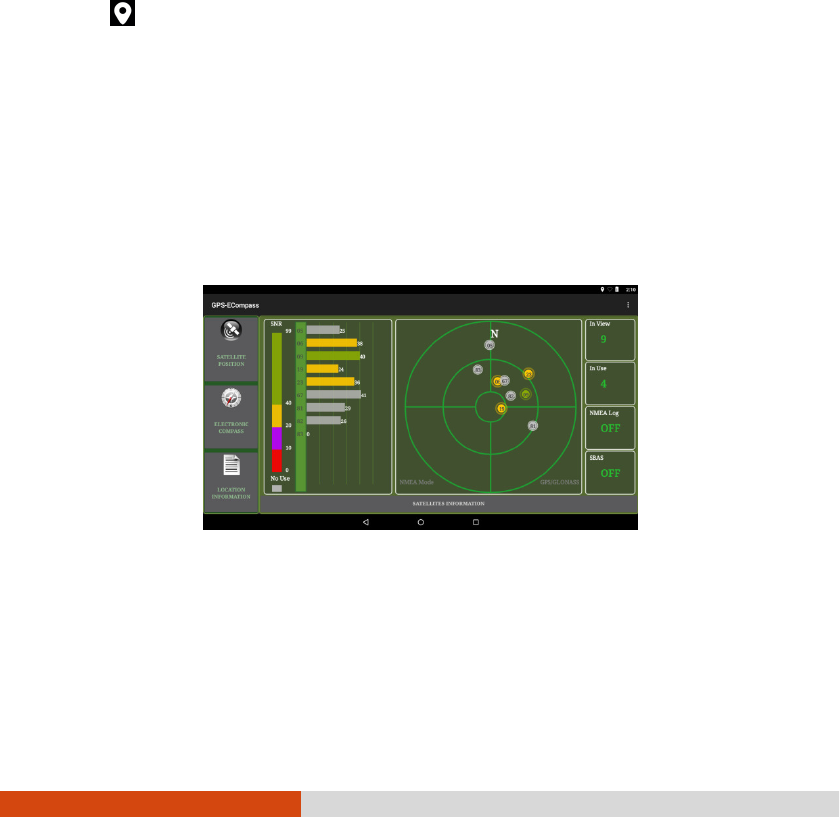
32
GPS
GPSGPS
GPS-
--
-ECompass
ECompassECompass
ECompass
GPS-ECompass can:
Function as a compass.
Receive GPS satellite signals to calculate the location of your device.
Record GPS logs.
When opening the application, you will be asked to turn on GPS if it is off. The
icon in the status bar indicates GPS service is in use.
The application has three pages as described later. Touch one of the three buttons
(Satellite Position, Electronic Compass, and Location Information) at the left side
of the screen to see the page.
Satellite Position
Satellite PositionSatellite Position
Satellite Position
The Satellite Position page shows the positions of the overhead satellites and their
signal strength. It also indicates the on/off status of the SBAS and logging functions.
SBAS (satellite-based augmentation system) provides additional accuracy and
reliability for the GPS devices. Ground stations are necessary to achieve the purpose.
The SBAS feature works where such stations exist. You can enable the SBAS feature.
(See “
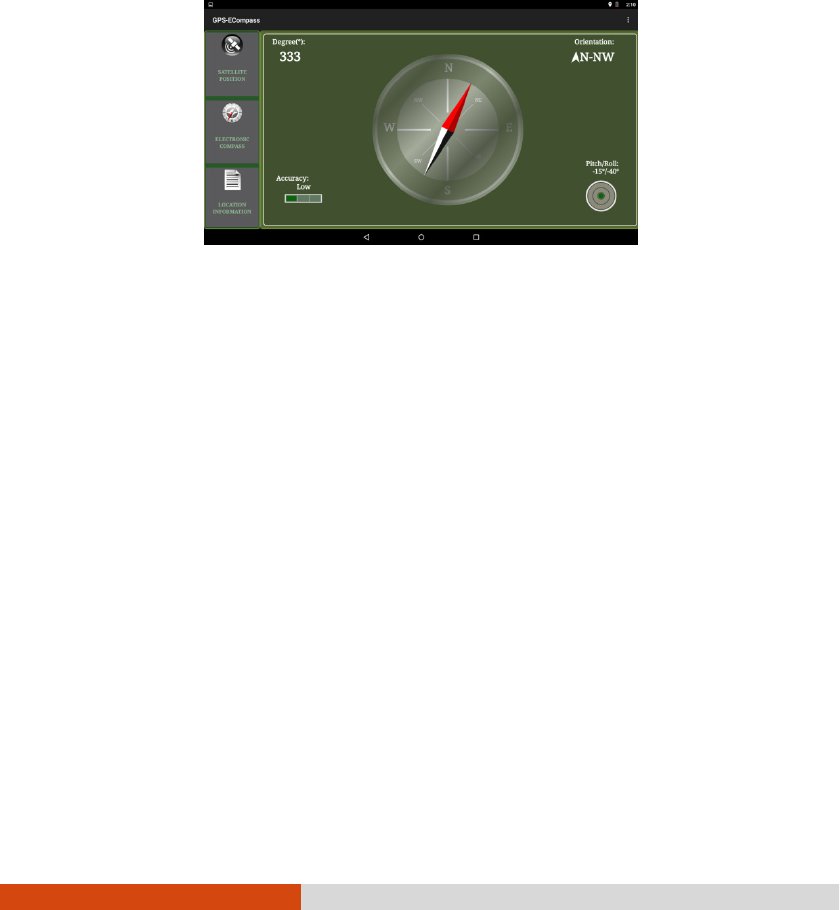
33
Getac Settings” in Chapter 7.)
E
EE
Electronic
lectronic lectronic
lectronic Compass
CompassCompass
Compass
The Electronic Compass page shows directions of movement including orientation,
pitch angle, roll angle, and azimuth angle.
The Accuracy reading is for your reference. When the application determines that
calibration is needed, it will pop up the “Calibration” graphics asking you to calibrate
the compass. Hold the device and swing it in the way as shown on the screen.
Do this several times until the popup graphics disappear.
NOTE: Follow these guidelines when using the compass.
Keep the device away from objects that generate magnetic
fields, such as cars, large belt buckles, computers, cell
phones, etc.
If you must use the compass inside a car, the device should
be at least 20 cm (7.87 inches) away from metal objects such
as car doors, dashboard, air vents, etc.
Avoid playing music with the internal speaker or connecting
the AC adapter. This will cause the magnetic interference
to the compass.
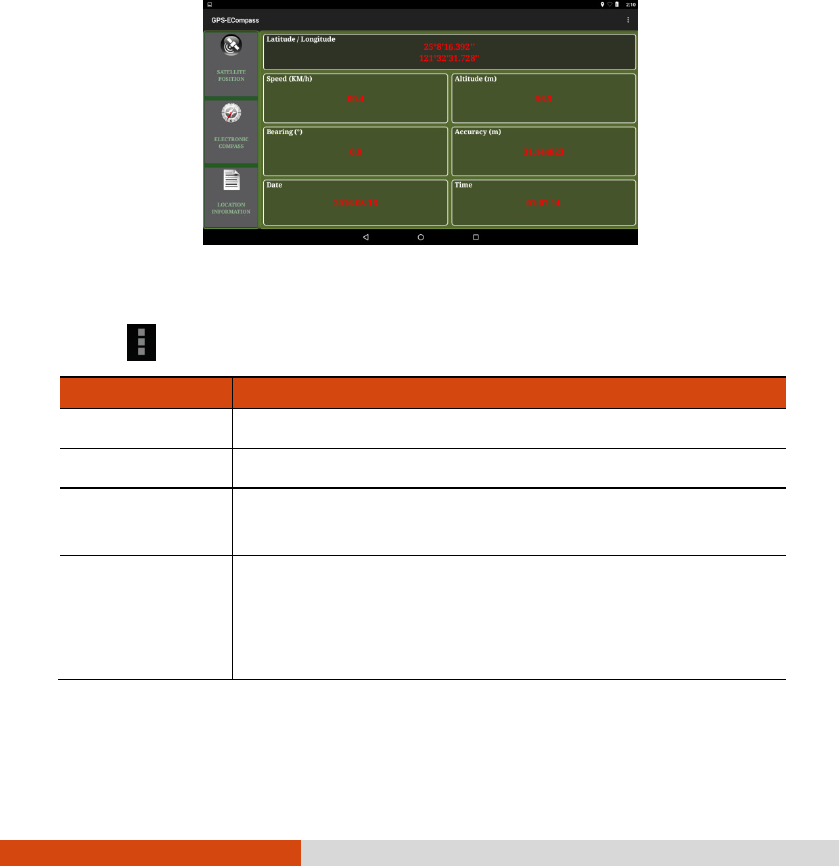
34
Location
LocationLocation
Location
Information
InformationInformation
Information
The Location Information page shows the geographic information of the current location
once GPS positioning is completed.
S
SS
Se
ee
ettings
ttingsttings
ttings
Touch and touch Setting.
Items
ItemsItems
Items
Descriptions
DescriptionsDescriptions
Descriptions
Location Service Check GPS satellites to turn on GPS receiver.
Satellites Log See the next subsection for information.
Rotation Type Set to Needle Compass
for a pivoting needle on a fixed dial
or Wheel Compass for a fixed needle on a rotating dial.
Display Check Calibration to display the Accuracy reading on the
Electronic Compass screen.
Check Balance to display the Pitch/Roll reading on the
Electronic Compass screen.
Touch OK for the changes to take effect.

35
GPS Logging
GPS LoggingGPS Logging
GPS Logging
You can record a GPS log file for the use of other applications. The output format
is NMEA.
1. Touch and touch Setting.
2. Touch Start to write Log in /storage/sdcard0/GpsLog.
3. In the selection menu that pops up, touch .. to accept the default folder for storing
the file.
If you want to specify a different folder, select it in the menu.
4. Touch OK. The recording will continue until you stop it.
5. To stop, touch and touch Setting. Touch Stop to write Log in ….
6. Touch OK.
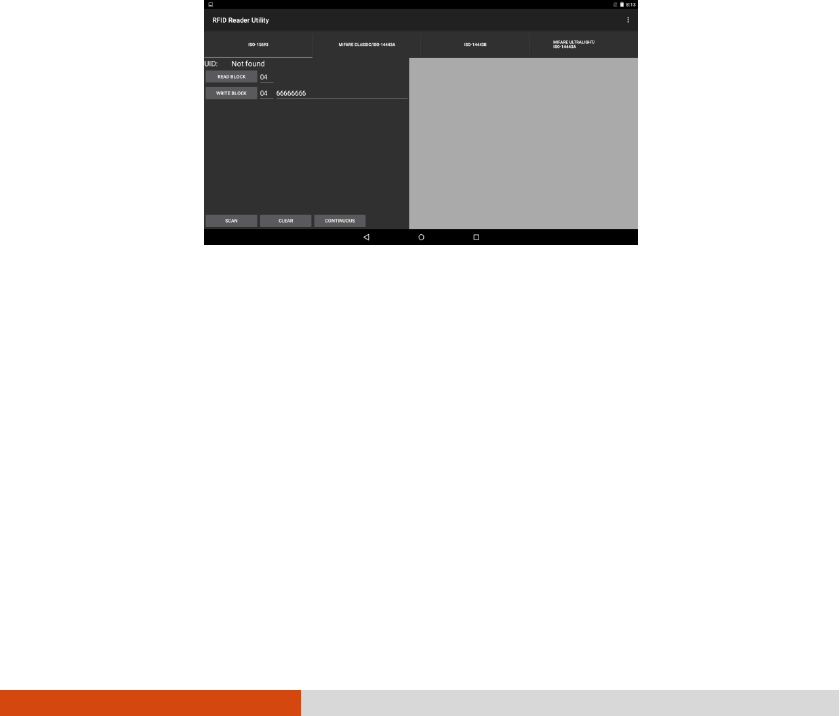
36
RFID Reader Utility (Select Models Only)
RFID Reader Utility (Select Models Only)RFID Reader Utility (Select Models Only)
RFID Reader Utility (Select Models Only)
RFID Reader Utility is a demo application that reads UID numbers from RFID tags.
NOTE: For enhanced applications and customization of the RFID
reader, contact your authorized Getac dealer.
1. Open the RFID Reader Utility application.
2. Touch the tag type you want to scan.
3. To scan one tag at a time, touch Scan. Or, press the Fn button on your device.
(The button is defined as Trigger by default.)
To scan continuously, touch Continuous.
4. Bring the tag near the RFID antenna.
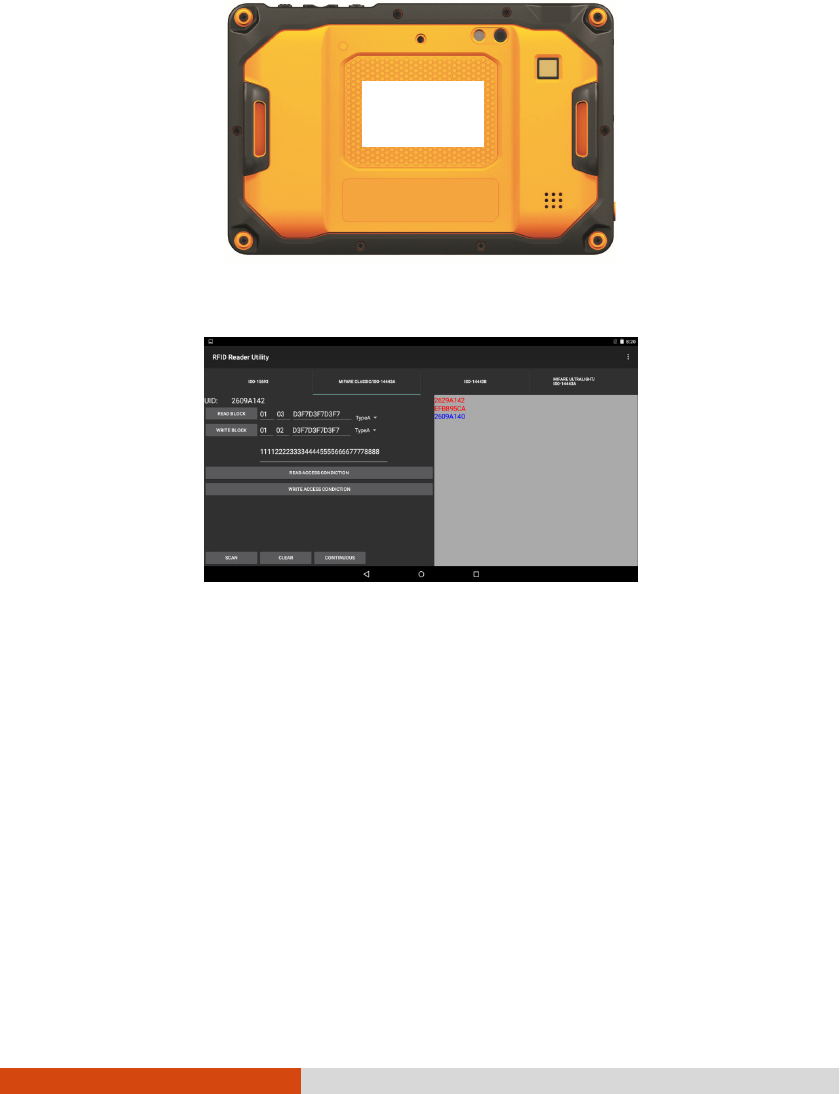
37
5. If a tag of the matching type is found, its UID is displayed in the data area.
6. If you are in continuous scanning mode, touch Stop to stop scanning.
7. You can touch Clear to clear the data area.
GU1000 UHF RFID Reader
GU1000 UHF RFID ReaderGU1000 UHF RFID Reader
GU1000 UHF RFID Reader
(Select Models
(Select Models (Select Models
(Select Models
Only)
Only)Only)
Only)
GU1000 is a utility that reads ultra high frequency RFID tags.
Location of
internal RFID
antenna

38

39
Chapter 6
Chapter 6Chapter 6
Chapter 6
Managing
ManagingManaging
Managing
Your Device
Your DeviceYour Device
Your Device
This chapter tells you how to manage power and configure your device.
Managing Power
Managing PowerManaging Power
Managing Power
The operating time of a fully charged battery depends on how you are using the
device. Some functions, such as using multimedia or operating an SD card, may
consume the battery power considerably.
Low Battery Signals and Actions
Low Battery Signals and ActionsLow Battery Signals and Actions
Low Battery Signals and Actions
CAUTION: When you recharge the battery upon a warning of low
power, you should charge for at least 30 minutes. If you unplug
the AC adapter soon, you may not have sufficient battery power
for your operation.
The battery status (charging or discharging) and level (as a percentage of fully
charged) are displayed at the top of the screen. To check the battery information,
go to Settings
Settings Settings
Settings
Battery
BatteryBattery
Battery.
You should save your data and recharge the battery immediately upon a warning
of low power; otherwise your device will turn off automatically. You need to connect
the device to external AC power for charging before you can use it again.

40
Power
PowerPower
Power-
--
-Saving Tips
Saving TipsSaving Tips
Saving Tips
You can extend your battery’s life between charges by turning off features that you
don’t need. You can also monitor how applications and system resources consume
battery power.
Turn off radios that you aren’t using.
Lower the screen brightness and set a shorter screen timeout.
Lower the volume.
If you don’t need it, turn off automatic syncing for all applications.
Avoid power-consuming applications. To check which applications consume the
most battery power, go to the Home screen, go to Settings
Settings Settings
Settings
Battery
BatteryBattery
Battery.
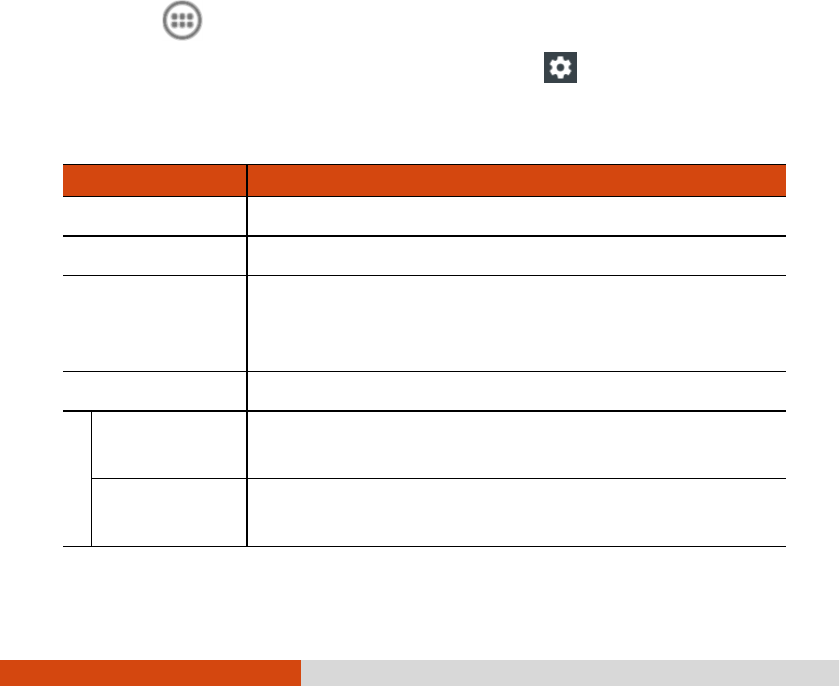
41
Settings
SettingsSettings
Settings
NOTE:
Incorrect settings may cause your system to malfunction. Make
sure that you fully understand the function of a certain item
before any adjustment.
Some setting items are available only for specific models
or applications you have in your device.
The Settings application contains most of the tools for customizing and configuring
your device.
To open Settings, use any of the below methods:
Tap the Settings
Settings Settings
Settings icon in the Home screen.
Touch (on the Home screen) Settings
SettingsSettings
Settings.
Open Quick Settings
Quick SettingsQuick Settings
Quick Settings and touch the Settings icon .
Wireless
Wireless Wireless
Wireless and N
and Nand N
and Networks
etworksetworks
etworks
Settings
SettingsSettings
Settings
Item
ItemItem
Item
Description
DescriptionDescription
Description
Wi-Fi To configure and use Wi-Fi.
Bluetooth To configure and use Bluetooth.
Data usage To view
the amount of data uploaded or downloaded by your
device during a given period.
You can set up conditions for
data usage.
More…
Airplane mode Slide the switch to the on position to
turns off all wireless
radios.
Tethering &
portable hotspot
To share your device’
s mobile data connection via USB or
as a portable Wi-Fi hotspot.
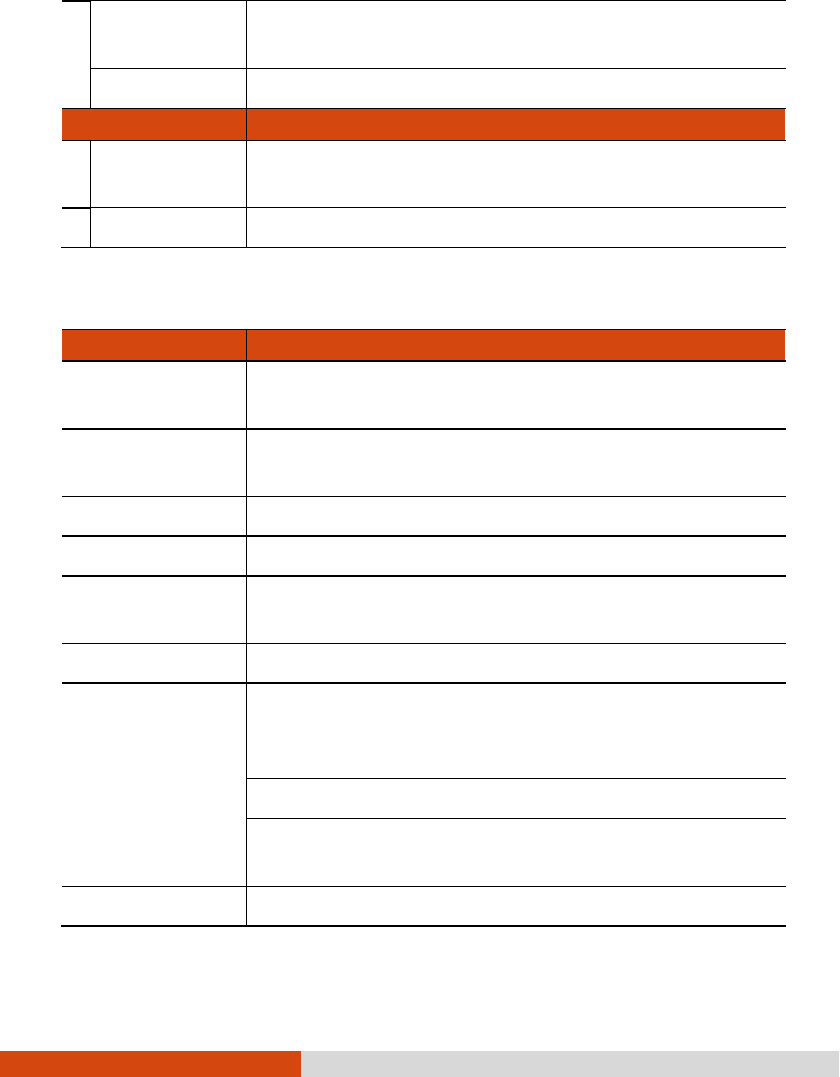
42
VPN To set the type of VPN to add and view the
list of VPNs
that you’ve previously configured.
Ethernet To configure Ethernet settings.
Item
ItemItem
Item
Description
DescriptionDescription
Description
Cellular
networks
To set up conditions for
your device's connections with mobile
data networks.
Mobile plan To view your mobile plan.
Device Settings
Device SettingsDevice Settings
Device Settings
Item
ItemItem
Item
Description
DescriptionDescription
Description
Display To set brightness, wallpaper, sleep timeout, auto rotate,
font
size, etc.
Sound & notification
To configure sound-
related settings such as volume, phone
ringtone, vibration with ringing, notification sound, etc.
Storage To view the used and available space on your device’s storage.
Battery To view battery usage data.
Apps To view details about the applications installed on
your device
and to manage them.
Users To add, change, or delete users.
Dock To set if you want to use the external antenna of the
dock
(when connected). You can also enable the auto switch
function.
To specify which audio output to use when docked.
Check to enable the sound that indicates your device
is inserted
to or removed from the dock.
Getac settings See below.
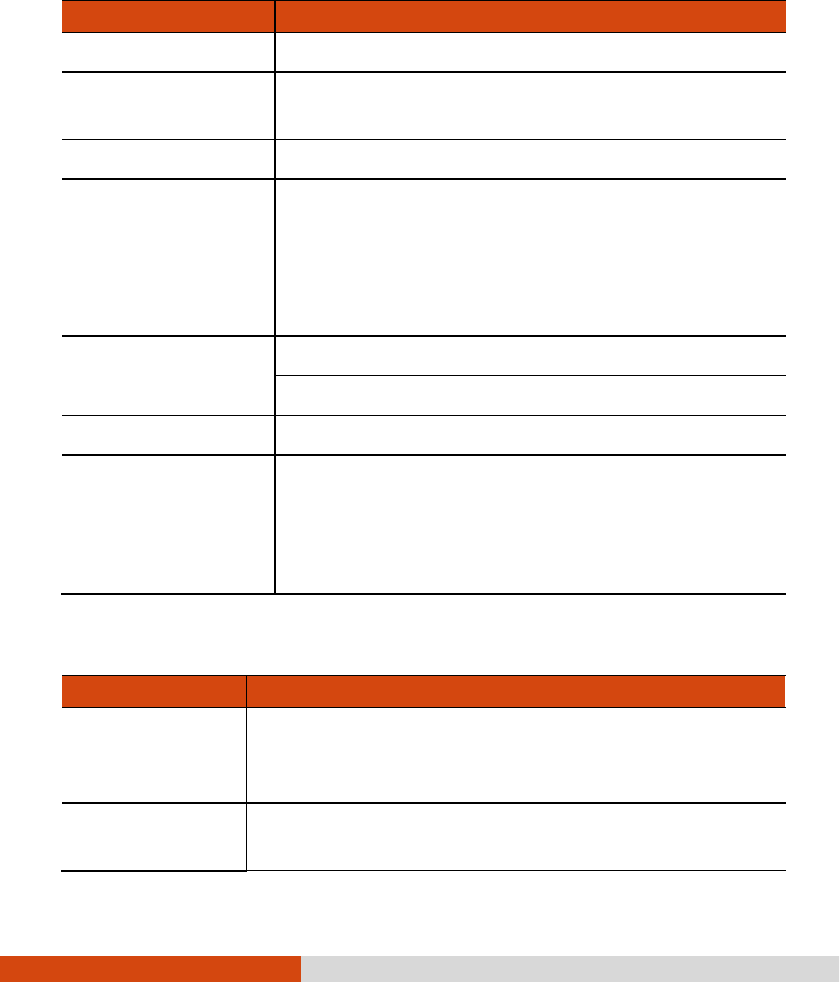
43
Getac
Getac Getac
Getac Settings
SettingsSettings
Settings
Item
ItemItem
Item
Description
DescriptionDescription
Description
Sensors status To view sensors data.
Physical buttons To assign a function
or application to a hardware button
on your device.
Modem config To configure the modem settings (if connected).
Common Criteria To toggle Common Criteria on/off.
“Common Criteria” is an international standard
(ISO/IEC 15408),
which define a common framework for
evaluating security features and capabilities of Information
Technology security products.
Barcode To toggle the barcode reader on/off.
To enable/disable barcode scan.
Fingerprint To enable/disable the fingerprint scanner.
Global Navigation
Satellite System
To toggle the below functions on/off.
• GPS
• GLONASS
• SBAS
Personal Settings
Personal SettingsPersonal Settings
Personal Settings
Item
ItemItem
Item
Description
DescriptionDescription
Description
Location To configure how you want your device to determine your
location and how you want to share your
location with Google
and others.
Security To configure screen lock, power-on password, device
administration, and credential storage.
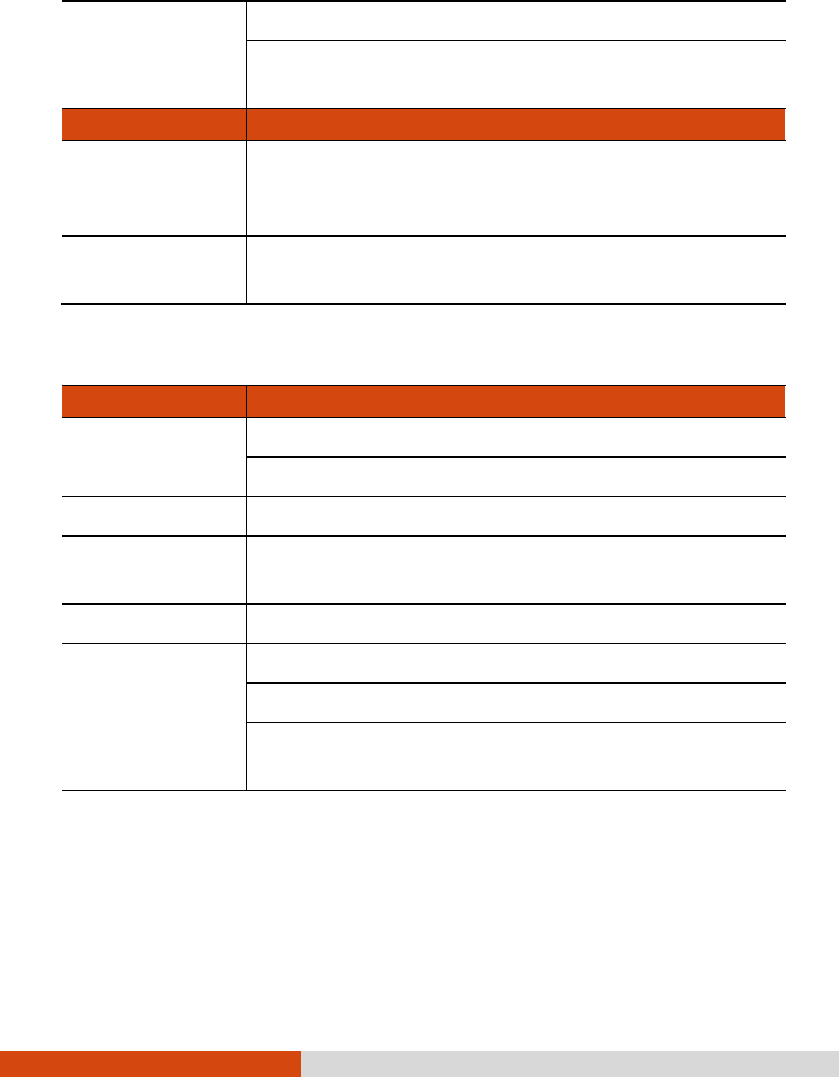
44
Accounts To add accounts.
The screen lists the account(s) you have added to the device.
To manage an account, touch it.
Item
ItemItem
Item
Description
DescriptionDescription
Description
Language & input To set up display language, personal dictionary, keyboard
language, input method, voice search, and text-to-speech
output.
Backup & reset To back up data and settings and to reset to
factory default
state.
System Settings
System SettingsSystem Settings
System Settings
Item
ItemItem
Item
Description
DescriptionDescription
Description
Date & time To use automatic data and time or to enter manually
To choose data and time format.
Accessibility To modify your device's accessibility settings
Printing To add printing services to
your device and to manage service
settings.
Developer options To set up options for developers.
About tablet To upgrade your device’s firmware.
To update the system.
To view legal, hardware, and software information of your
device.

45
Chapter 7
Chapter 7Chapter 7
Chapter 7
Care and
Care andCare and
Care and
Maintenance
MaintenanceMaintenance
Maintenance
This chapter provides guidelines on taking care of your device.
Resetting Your Device
Resetting Your DeviceResetting Your Device
Resetting Your Device
To restart the device, press and hold the power button until a menu pops up. Touch
Power off
Power offPower off
Power off and then Reboot
RebootReboot
Reboot.
In case the device stops responding to your operation, you can force the device
to power off by pressing and holding the power button for more than 10 seconds.
Then turn it on again.
Caring
Caring Caring
Caring f
ff
for
oror
or
Your
Your Your
Your Device
DeviceDevice
Device
Taking good care of your device will ensure trouble-free operation and reduce the
risk of damage to your device.
Keep your device away from excessive moisture and extreme temperatures.
Avoid exposing your device to direct sunlight or strong ultraviolet light for extended
periods of time.
Do not place anything on top of your device or drop objects on your device.
Do not drop your device or subject it to severe shock.
Do not subject your device to sudden and severe temperature changes. This
could cause moisture condensation inside the unit, which could damage your

46
device. In the event of moisture condensation, allow your device to dry out
completely before use.
The screen surface can easily be scratched. Avoid touching it with sharp objects.
Non-adhesive generic screen protectors designed specifically for use on portable
devices with LCD panels may be used to help protect the screen from minor
scratches.
Never clean your device with it powered on. Use a soft, lint-free cloth to wipe
the screen and the exterior of your device.
Do not use paper towels to clean the screen.
Never attempt to disassemble, repair or make any modifications to your device.
Disassembly, modification or any attempt at repair could cause damage to your
device and even bodily injury or property damage and will void the warranty.
Do not store or carry flammable liquids, gases or explosive materials in the
same compartment as your device, its parts or accessories.

47
Chapter 8
Chapter 8Chapter 8
Chapter 8
Regulatory Information
Regulatory InformationRegulatory Information
Regulatory Information
NOTE: Marking labels located on the exterior of your device
indicate the regulations that your model complies with. Please
check the marking labels on your device and refer to the
corresponding statements in this chapter. Some notices apply
to specific models only.
Regulations Statements
Regulations StatementsRegulations Statements
Regulations Statements
USA
USAUSA
USA
Class B Regulations
Class B RegulationsClass B Regulations
Class B Regulations
Federal Communications Commission Radio Frequency Interference Statement
NOTE:
NOTE:NOTE:
NOTE:
This device complies with Part 15 of the FCC Rules. Operation is subject
to the following two conditions: (1) This device may not cause harmful interference,
and (2) this device must accept any interference received, including interference
that may cause undesired operation. These limits are designed to provide reasonable
protection against harmful interference in a residential installation. This equipment
generates, uses, and can radiate radio frequency energy and, if not installed and
used in accordance with the instructions, may cause harmful interference to radio
communications. However, there is no guarantee that interference will not occur in
a particular installation. If this equipment does cause harmful interference to radio
or television reception, which can be determined by turning the equipment off and
on, the user is encouraged to try to correct the interference by one or more of the
following measures:
Reorient or relocate the receiving antenna.

48
Increase the separation between the equipment and receiver.
Connect the equipment into an outlet on a circuit different from that to which
the receiver is connected.
Consult the dealer or an experienced radio/TV technician for help.
Any changes or modifications not expressly approved by the manufacturer could void
the user’s authority to operate the equipment.
Please note:
Please note:Please note:
Please note:
The use of a non-shielded interface cable with this equipment is prohibited.
Industry Canada statement
This device complies with Industry Canada license-exempt RSS standard(s).
Operation is subject to the following two conditions:
1) this device may not cause interference, and
2) this device must accept any interference, including interference that may
cause undesired operation of the device.
Le présent appareil est conforme aux CNR d'Industrie Canada applicables aux
appareils radio exempts de licence. L'exploitation est autorisée aux deux
conditions suivantes:
1) l'appareil ne doit pas produire de brouillage, et
2) l'utilisateur de l'appareil doit accepter tout brouillage radioélectrique subi,
même si le brouillage est susceptible d'en compromettre le fonctionnement.
This Class B digital apparatus complies with Canadian ICES-003.
Cet appareil numérique de la classe B est conforme à la norme NMB-003
du Canada.
This device and its antenna(s) must not be co-located or operating in
conjunction with any other antenna or transmitter, except tested built-in radios.
Cet appareil et son antenne ne doivent pas être situés ou fonctionner en
conjonction avec une autre antenne ou un autre émetteur, exception faites des
radios intégrées qui ont été testées.

49
The County Code Selection feature is disabled for products marketed in the
US/ Canada.
La fonction de sélection de l'indicatif du pays est désactivée pour les produits
commercialisés aux États-Unis et au Canada.
FOR PORTABLE DEVICE (<20cm from body / SAR needed)
Radiation Exposure Statement:
The product comply with the Canada portable RF exposure limit set forth for an
uncontrolled environment and are safe for intended operation as described in this
manual. The further RF exposure reduction can be achieved if the product can be
kept as far as possible from the user body or set the device to lower output power
if such function is available.
Déclaration d'exposition aux radiations:
Le produit est conforme aux limites d'exposition pour les appareils portables RF pour
les Etats-Unis et le Canada établies pour un environnement non contrôlé.
Le produit est sûr pour un fonctionnement tel que décrit dans ce manuel. La réduction
aux expositions RF peut être augmentée si l'appareil peut être conservé aussi loin
que possible du corps de l'utilisateur ou que le dispositif est réglé sur la puissance
de sortie la plus faible si une telle fonction est disponible.
FOR WLAN 5GHZ DEVICE:
Caution :
1) the device for operation in the band 5150-5250 MHz is only for indoor use
to reduce the potential for harmful interference to co-channel mobile satellite
systems;
2) the maximum antenna gain permitted for devices in the bands 5250-5350
MHz and 5470-5725 MHz shall comply with the e.i.r.p. limit; and
3) the maximum antenna gain permitted for devices in the band 5725-5825 MHz
shall comply with the e.i.r.p. limits specified for point-to-point and non
point-to-point operation as appropriate.

50
4) the worst-case tilt angle(s) necessary to remain compliant with the
e.i.r.p. elevation mask requirement set forth in Section 6.2.2(3)
shall be clearly indicated.
5)
Users should also be advised that high-power radars are allocated as primary
users (i.e. priority users) of the bands 5250-5350 MHz and 5650-5850
MHz and that these radars could cause interference and/or damage to LE-LAN
devices.
Avertissement:
1) les dispositifs fonctionnant dans la bande 5150-5250 MHz sont réservés
uniquement pour une utilisation à l’intérieur afin de réduire les risques de
brouillage préjudiciable aux systèmes de satellites mobiles utilisant les mêmes
canaux;
2) le gain maximal d’antenne permis pour les dispositifs utilisant les bandes
5250-5350 MHz
et 5470-5725 MHz doit se conformer à la limite de p.i.r.e.;
3) le gain maximal d’antenne permis (pour les dispositifs utilisant la bande
5725-5825 MHz) doit se conformer à la limite de p.i.r.e. spécifiée pour
l’exploitation point à point et non point à point, selon le cas.
4) les pires angles d’inclinaison nécessaires pour rester conforme à
l’exigence de la p.i.r.e. applicable au masque d’élévation, et énoncée
à la section 6.2.2 3), doivent être clairement indiqués.
5)
De plus, les utilisateurs devraient aussi être avisés que les utilisateurs de radars
de haute puissance sont désignés utilisateurs principaux (c.-à-d., qu’ils ont
la priorité) pour les bandes 5250-5350 MHz
et 5650-5850 MHz et que ces radars pourraient causer du brouillage et/ou
des dommages aux dispositifs LAN-EL.

51
European Union CE
European Union CE European Union CE
European Union CE Marking and Compliance
Marking and Compliance Marking and Compliance
Marking and Compliance
Notices
NoticesNotices
Notices
Statements of Compliance
Statements of ComplianceStatements of Compliance
Statements of Compliance
English
EnglishEnglish
English
This product follows the provisions of the European Directive 1999/5/EC.
Danish
DanishDanish
Danish
Dette produkt er i overensstemmelse med det europæiske direktiv 1999/5/EC.
Dutch
DutchDutch
Dutch
Dit product is in navolging van de bepalingen van Europees Directief 1999/5/EC.
Finnish
FinnishFinnish
Finnish
Tämä tuote noudattaa EU-direktiivin 1999/5/EC määräyksiä.
French
FrenchFrench
French
Ce produit est conforme aux exigences de la Directive Européenne 1999/5/EC.
German
GermanGerman
German
Dieses Produkt entspricht den Bestimmungen der Europäischen Richtlinie 1999/5/EC.
Greek
GreekGreek
Greek
To προϊόν αυτό πληροί τις προβλέψεις της Ευρωπαϊκής Οδηγίας 1999/5/EC.
Icelandic
IcelandicIcelandic
Icelandic
Þessi vara stenst reglugerð Evrópska Efnahags Bandalagsins númer 1999/5/EC.
Italian
ItalianItalian
Italian
Questo prodotto è conforme alla Direttiva Europea 1999/5/EC.
Norwegian
NorwegianNorwegian
Norwegian
Dette produktet er i henhold til bestemmelsene i det europeiske direktivet 1999/5/EC.
Portuguese
PortuguesePortuguese
Portuguese
Este produto cumpre com as normas da Diretiva Européia 1999/5/EC.
Spanish
SpanishSpanish
Spanish
Este producto cumple con las normas del Directivo Europeo 1999/5/EC.

52
Swedish
SwedishSwedish
Swedish
Denna produkt har tillverkats i enlighet med EG-direktiv 1999/5/EC.
Restrictions
RestrictionsRestrictions
Restrictions
This device is restricted to indoor use when operating in the 5150 to 5350 MHz
frequency range.
Safety Precautions
Safety PrecautionsSafety Precautions
Safety Precautions
Prolonged listening of music in maximum volume can damage the ears.
The use of headphones other than those recommended/supplied can cause
hearing impairment due to excessive sound pressure.
Caution for service personnel: Risk of explosion if battery is replaced by an
incorrect type. Dispose of used batteries according to the instructions.
About Charging
About ChargingAbout Charging
About Charging
Use only the AC adapter supplied with your device. Use of another type of
AC adapter will result in malfunction and/or danger.
Use only the car charger supplied by the manufacturer. Use of another type
of car charger will result in malfunction and/or danger.
This product is intended to be supplied by a LISTED Power Unit marked with
“LPS,” “Limited Power Source,” and output rated + 12 V dc / 2.0 A.
Use a specified cradle approved by the manufacturer.
Use a specified battery in the equipment.
About the
About the About the
About the AC Adapter
AC AdapterAC Adapter
AC Adapter
Do not use the AC adapter in a high moisture environment. Never touch the
AC adapter when your hands or feet are wet.

53
Allow adequate ventilation around the AC adapter when using it to operate the
device or charge the battery. Do not cover the AC adapter with paper or other
objects that will reduce cooling. Do not use the AC adapter while it is inside
a carrying case.
Connect the AC adapter to a proper power source. The voltage and grounding
requirements are found on the product case and/or packaging.
Do not use the AC adapter if the cord becomes damaged.
Do not attempt to service the unit. There are no serviceable parts inside. Replace
the unit if it is damaged or exposed to excess moisture.